Peter Newell Lures - NSW:
* Banner image is of a very rare Newell 'Mc Sea Scorpion' inspired by feedback from Vic Mc Cristal
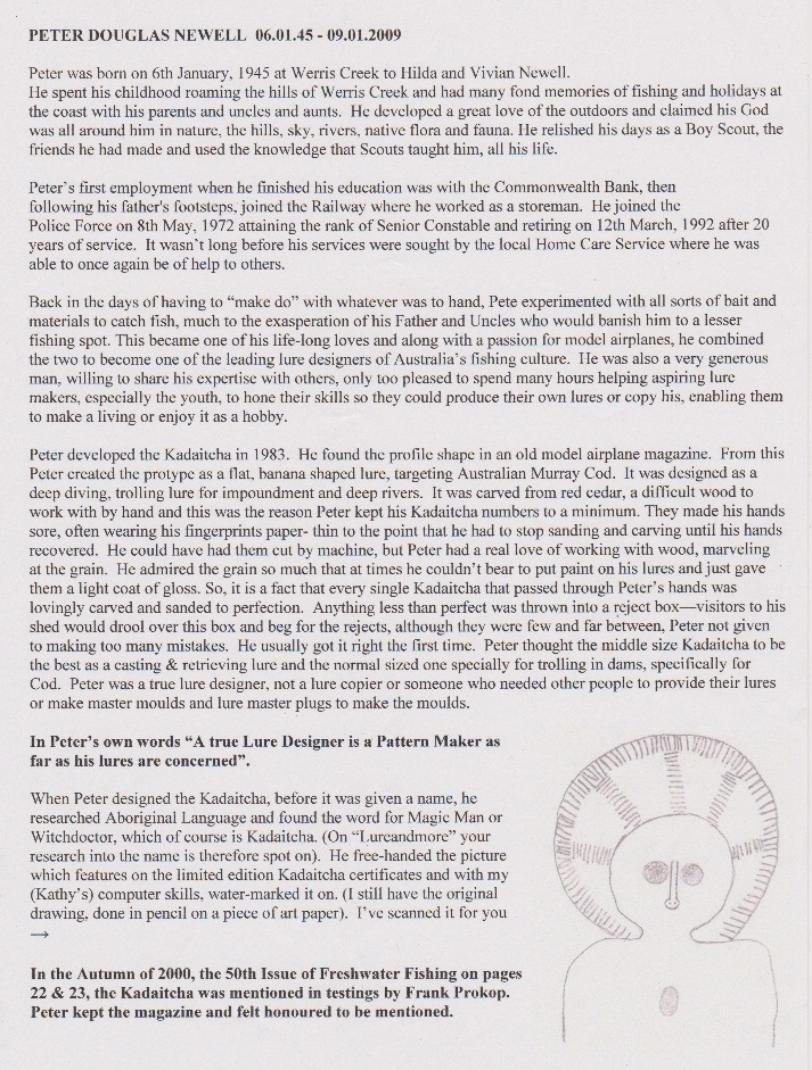
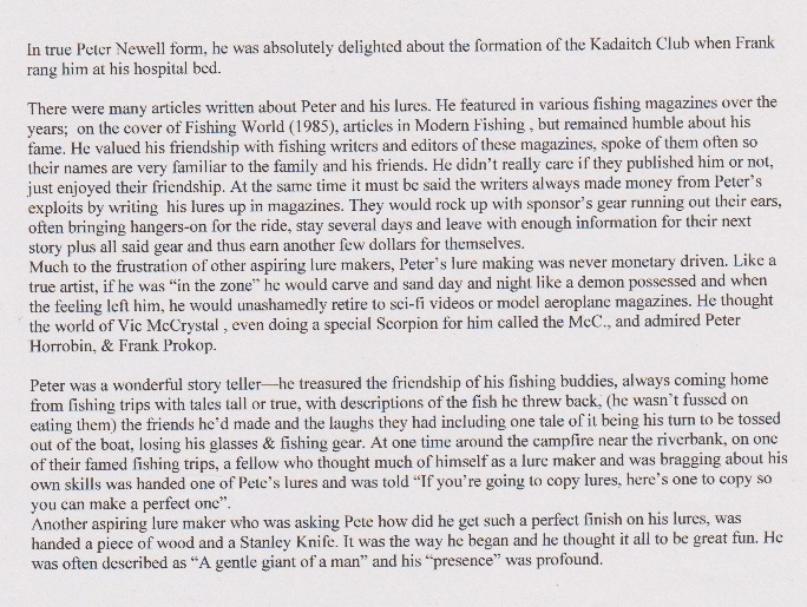
*The above was kindly shared with permission from Kathy Newell and is a snapshot of Peter Newell's life and the history of the 'Kadaitcha' - the luremaking process and the passion for a better fishing lure. This would not of been possible without the help of Debbie Dare and the generosity of Kathy who undoubtedly knew Peter best.
Arguably the most influential Australian lure maker to date, Peter Douglas Newell developed a range of hand carved timber lures perfectly suited to targeting Australian native fish. With his untimely passing in January 2009, his lures have come to be the benchmark for the 'classic' Australian style of lure, highly valued and admired by collectors around the world but particularly in Australia. Peter Newell is credited with influencing Rob Gaden, Trevor McFeeters, Travers Powell, Brett Campbell and many other lure makers with whom he shared his immense knowledge of lure making either directly or indirectly. Peter was an Indigenous man hence many of his names derive from Aboriginal language; Kadaitcha is Aboriginal, Mirri is the Kamilaroi or Gamilaraay word for Dog/Dingo. The Kamilaroi or Gamilaraay clan come from northern NSW, from around Tamworth west across and beyond Moree.
The Early Newell Lures:
The Newell lure story really starts around the mid to late 1960's (Peter was making lures for a long time before he decided to produce lures commercially). There are examples of early Newell lures when Peter started shaping up lures for his own use. Tenterfield in northern NSW has had a long tradition of luremakers utilising local timbers such as red cedar for making quality fishing lures targeting native fish. Compared to some of his later creations, early Newell lures were made as modified copies of successful imported lures such as the Nilsmaster 'Invincible' which is the inspiration for the early 'Chin Minnow', the Cordell 'Big O' resembling the 'Guppy' and the Helins 'Flatfish' which influenced the Kadaitcha.
There is an example which was shown to Lure Hub OZ by Brian Dare (who was a good friend of Peter) which was a modified and re painted T60 Flatfish and Brian emphasised that Peter was heavily influenced by imported lures and especially Heddon lures - he had a couple of older books about the Heddon company that he loved to read all the time.
Below is shown two early Peter Newell lures - the top blank is an unfinished blank with a Newell version of the Nilsmaster which was one of his favourite lures. The bottom lure is a smaller version with a deeper diving bib.
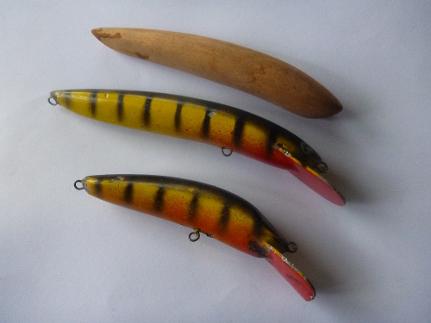
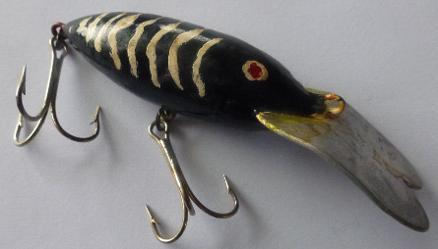
The lures above and below are two of the earliest Newell lures and date c.1966 when Peter was 20 years old (he was making lures from the age of 16). It could probably be viewed as pretty 'rough' when compared to some of the sleek designs developed later as Peter became a master lure maker however these lures are an iconic part of Australia's lure history - it provides the proof that everyone starts somewhere and supports the old saying that 'if you develop a skill and practice for 10,000 hours, you will more than likely become an expert'. Undoubtedly Peter started in the same place every other lure maker does - observing and then experimenting making copies of their favourite lures. These two have a distinct look of large Storm Hot 'n Tots which were a highly successful and popular lure of the time.
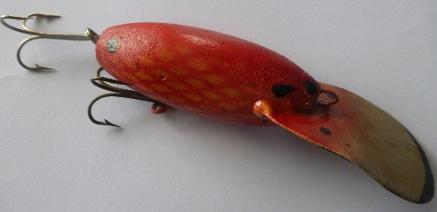
Left is shown a very early Newell lure which is obviously a Nilsmaster copy, hand painted and featured with the later Peter Newell article that was published in Modern Fishing, September 1983.
The Newell 'Chin Minnow' and 'Banana Minnow':
It is worth mentioning these early designs as they were mentioned in Peter Newells 'Roll Your Own' article published in 1983 and were an early part of Peter's lure making history.
Below is shown a couple of Chin Minnow blanks.
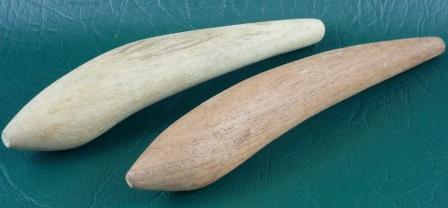
The Newell 'Beluga':
Another early model that was being developed at the same time as the 'Scorpion' and 'Kadaitcha' designs in the early 1980's. They came in three sizes as shown right.
The lure below is an early metal bibbed Newell 'Beluga' c.1983
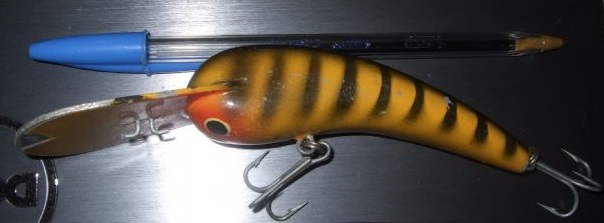
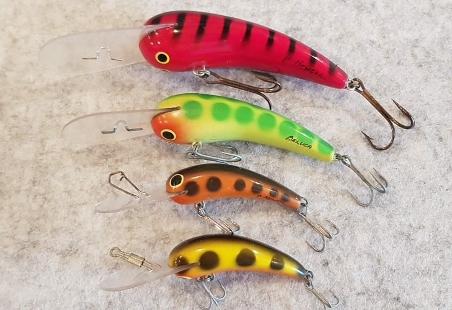
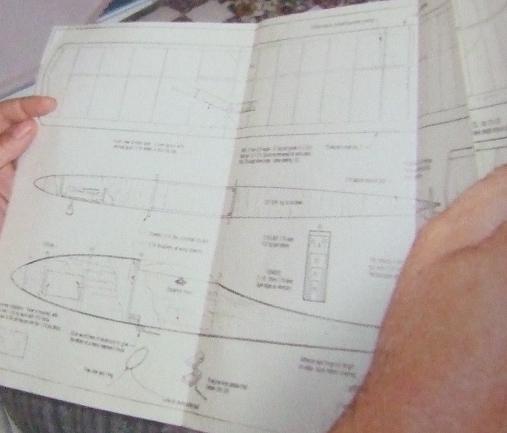
Above - Peter Newell analysing the plans of an aircraft model - one of his favourite interests was in aeroplanes.
Travers Powell relates a story about the design of the original Scorpion from his days in Tenterfield;
'Peter had a keen interest in aeroplanes. About 20 years ago, in his
'workshop', Peter told me about using wing cross-section profiles to get
the shape of the Scorpion. He photocopied the page that he used and
gave it to me (scanned copy below). Peter believed that the aerodynamic
features of a wing might be useful in the hydrodynamics of a lure.'
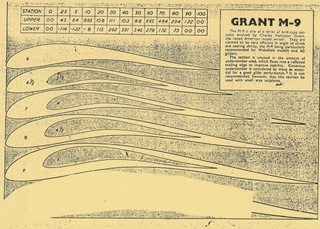
The Kadaicha/Kadaitcha was developed along similar principles.
Lure Lovers forum
'I ventured to Tenterfield this week to take a peek at the display put
in the Visitors centre on behalf of Peter Newell. I read the story
written by Kathy Newell and is stated that the Kadaitcha was developed
in 1983 by Peter. Quote: He found the idea of a profile shape in an old
model airplane magazine. From this Peter created the protype as a flat
banana shaped lure, targeting Australian Murray Cod. Thanks . . . for the confirmation of what Peter told me many years ago. Peter said he designed the Kad while he was a police officer in Inverell
(1983) and it was modelled after the profile of a plane wing. Both
facts I have been told . . . came direct
from Peter'.
The Newell 'Scorpion':
The story of the Newell Scorpion is a long one starting with the development of the lure by Peter Newell in the early 1980's and subsequent patented design of the scorpion in the USA in May 1987. What many people are not aware of is that an early range of Peter Newell's lures were called 'Scorpion Lures' with the name subsequently being changed due to legal action by Halco which did not allow the name as they now owned the rights to make and market the 'Scorpion' and the history is related below.
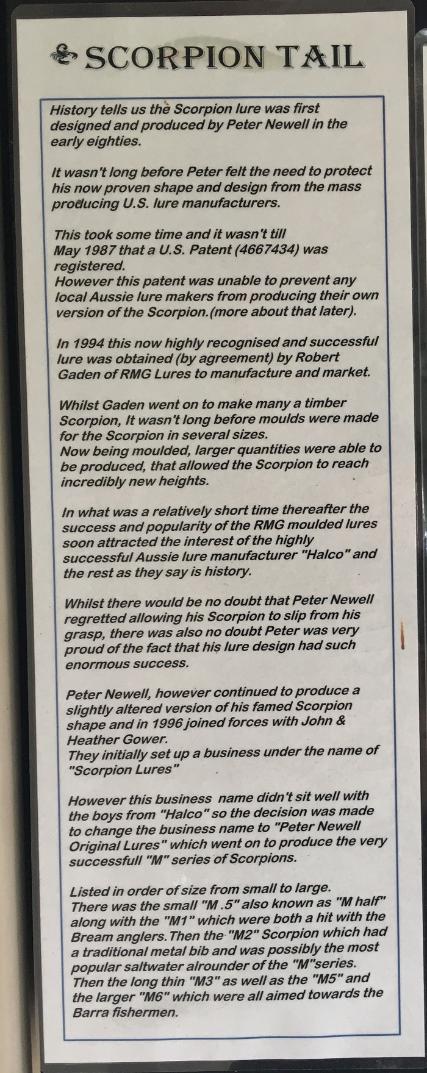
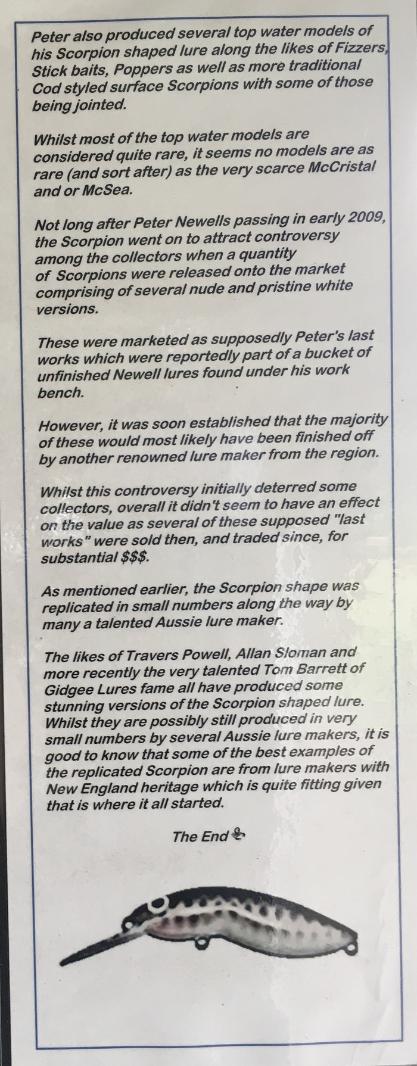
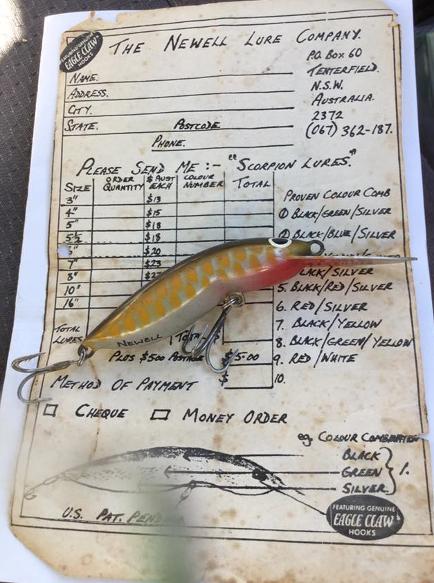
(Opposite) The very earliest order form for 'Scorpion Lures' from the Newell Lure Company listing 9 proven colour combinations and scorpion sizes from 3 inch to 16 inch model. Includes the prices that were charged for each model.
(Below) A Scorpion Lures T shirt - a truly rare item
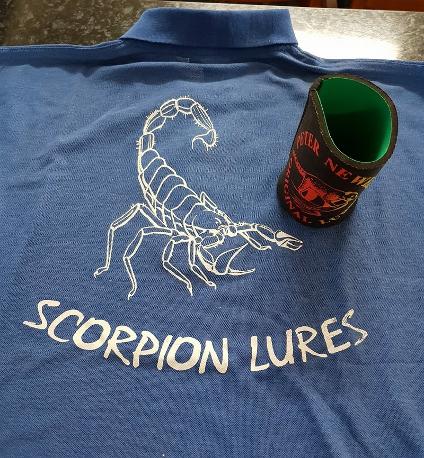
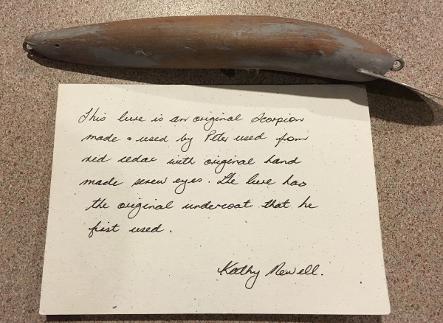
(Below) Example of large Newell scorpion blank, carved timber blank and finished product in Australian red cedar.



Newell Scorpions - an example of the timber bodies and 'nude' finish lures showing the range of sizes that were available.
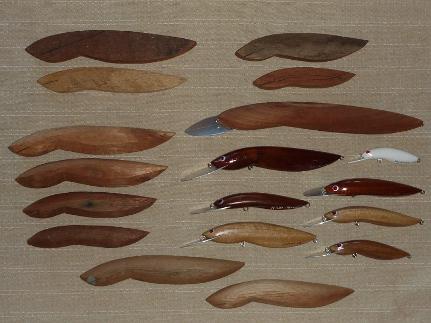
One of the rarest Newell Scorpion Lures is the Mc Sea Scorpion. shown below with an early 'Guppy' shape with the pronounced hump - both clear coated or 'nude'.
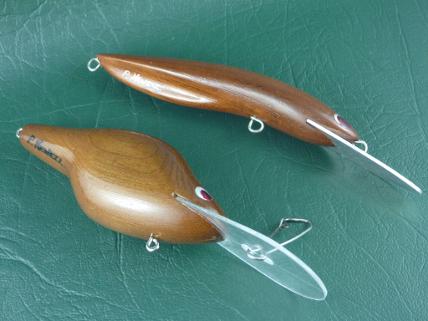
Extract from Lure Lovers forum;
Here's a small transcript from the recorded interview discussing the Newell McSea Scorpion. The discussion took place at Vic Mc Cristal's house in Cardwell, QLD in Nov 2009 with Barry Cross;
Barry - Vic what can you tell us about this Scorpion lure here made by Peter Newell?
Vic
- Well this particular one developed out of what Peter had made some of
his conventional Scorpions and sent them up to me and I used them
mainly for trolling for fingermark and they worked well. But I came up
with the idea of the slotted bottom to make more noise when it wobbled,
and because it faces slightly down as well as out on each side I figured
it would put out a sound wave to each side of the lure. It is quite a
shapely lure too and you don't see many like that, in fact I don't think
there was another like it.
Barry - No I can't say that in all the years that I have watched lures that I have seen anything like it as well.
Vic - Every lure that the bloke made was perfect.
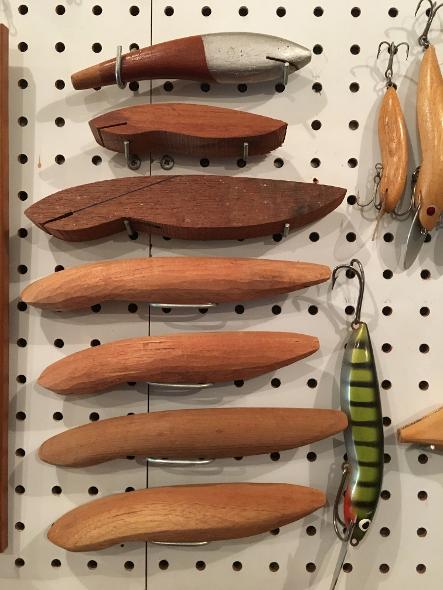
The lure shown below is a Newell snub nosed 'Guppy' that is signed 'Scorpion Lures'. These lures are extremely rare as they were only ever produced for a short time before the Halco legal action commenced.
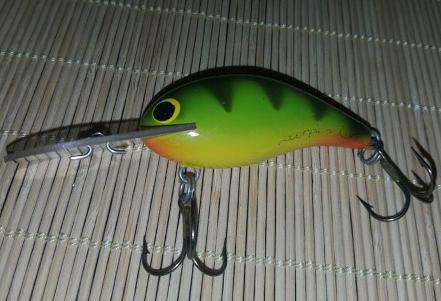
(Below) The 'Lik Lik' came about because Rod Harrison wanted a smaller Scorpion to take to PNG with him. Peter made the smaller one and called it the 'Lik Lik'. The 'Lik Lik' Scorpion was the first of the original 3 inch scorpions carved by Peter Newell. 'Lik Lik' is Pidgin English (common in PNG) and means 'small', possibly something Rod Harrison picked up from his trips there.
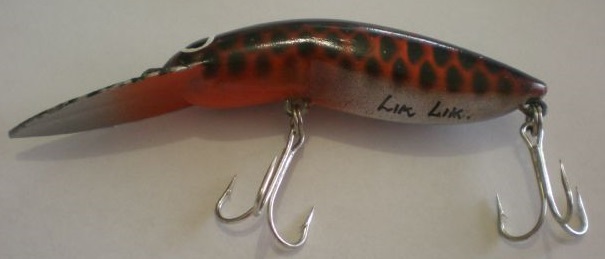
Some examples of 'Scorpion' and 'Lik Lik' bodies to show the minor differences in size and shaping
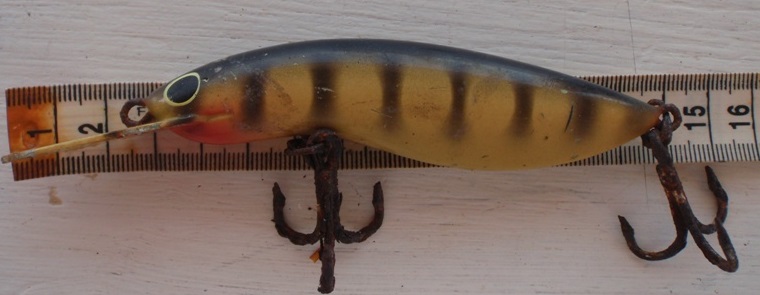
Here's another great story about a special lure from Simon Bruce;
'One my recent Kimberley trip had a discussion with the proprietor of the camp, Robert "Bluey" Vaughan and one of the guides, Colin Finch about this lure collecting caper. At the camp the roof of the main camp kitchen eating area is a pole arrangement with paperbark laid on chicken mesh. This makes a handy resting place for retired lures that have been retired after glorious victory or severe maiming. Anyway we had a bit of a look through the rafters and came up with a Norm Edwards and it transpires that Bluey spent some time making lures for Norm Edwards on Blueys honeymoon in the mid eighties. Had a bit of a discussion about N Edwards and other manufacturers. A few Bounty hunters lurked up there along with some well chewed Leads and even an A&B Tiny boy
He then retrieved a lure given to him by Dean
Butler and consigned to the same area, Dean Butler did mention to him
that this would be worth hanging onto. I told Bluey that a P Newell scorpion should probably be hanging on the wall of his house as a special lure'
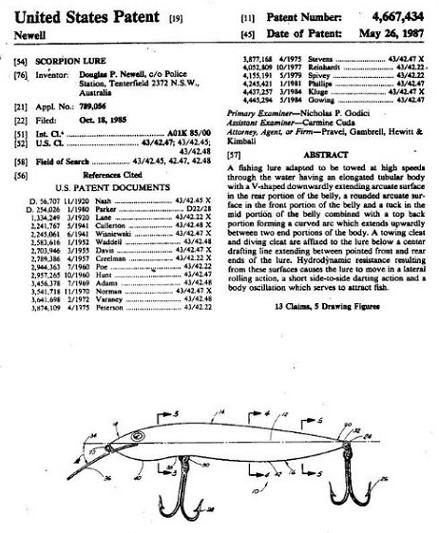
The Scorpion Patent was registered in the United States as Peter Newell believed that was where any copies would come from.
The original Newell 'Scorpion' was made in a number of sizes and will be referred to as Newell M1, M2, M3 or the larger Newell 5 and Newell 6. These are all 'Scorpion' models and designs however as many Newell collectors have pointed out there is alot of variation and many special order colours that were not catalogued.
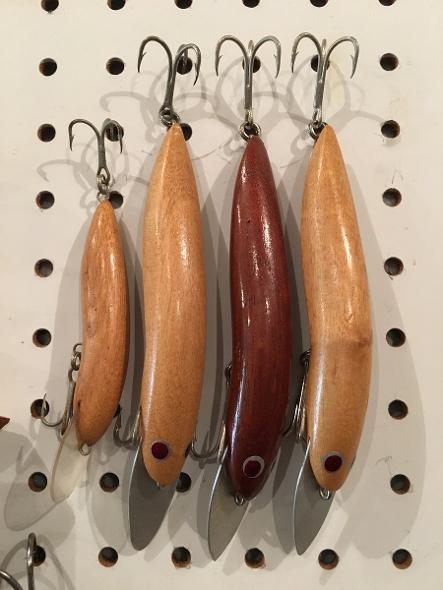
Pat. Abstract;
"A fishing lure adapted to be towed at high speeds through the water having an elongated tubular body with a V-shaped downwardly extending arcuate surface in the rear portion of the belly, a rounded arcuate surface in the front portion of the belly and a tuck in the mid portion of the belly combined with a top back portion forming a curved arc which extends upwardly between two end portions of the body. A towing cleat and diving cleat are affixed to the lure below a center drafting line extending between pointed front and rear ends of the lure. Hydrodynamic resistance resulting from these surfaces causes the lure to move in a lateral rolling action, a short side-to-side darting action and a body oscillation which serves to attract fish."
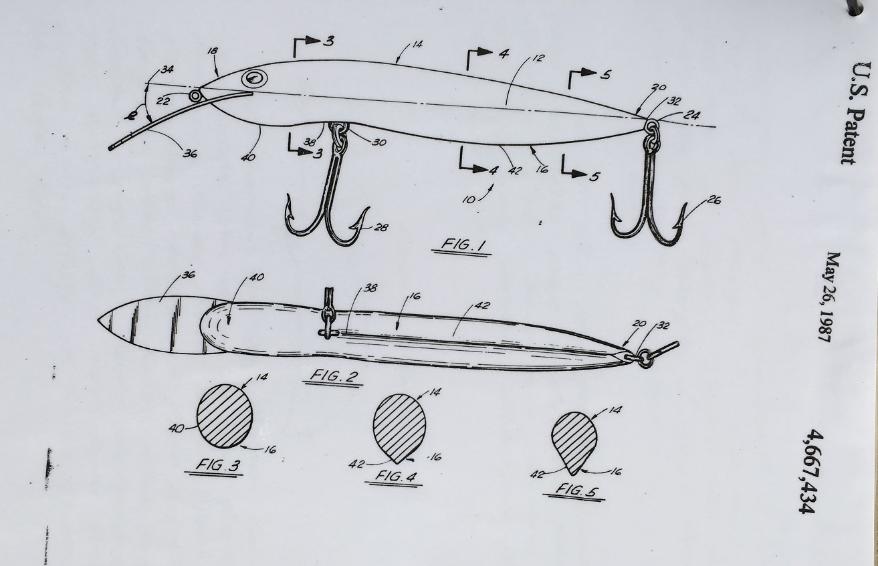
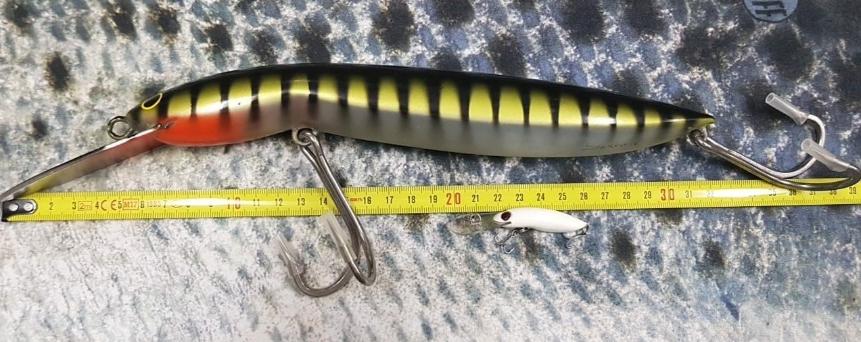
Original Newell 'Scorpion' - the big (with 20 stripes) and the small
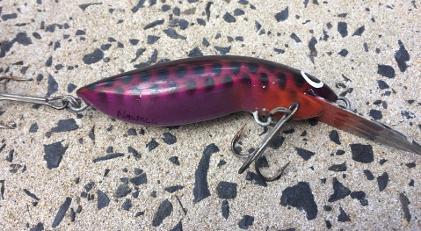
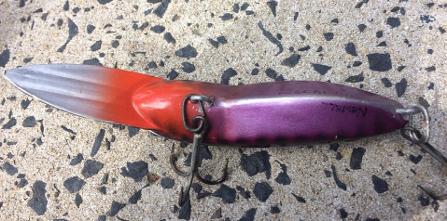
Above - An older Newell 'Scorpion' in purple with original oval split rings and trebles
Below - An evtremely rare green Newell ' Mc Cristal Scorpion' signed by Vic on the bib
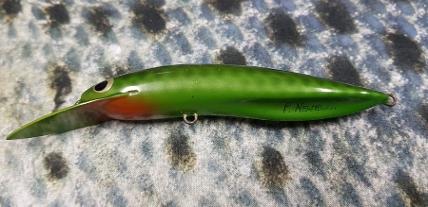
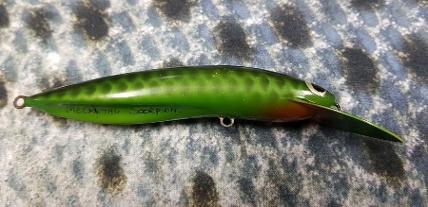
The following photos show a wide range of Scorpions made by Peter Newell.
(Left) Some early Newell Scorpions in various sizes that belonged to Trevor Mc Feeters.
A tiny Newell Scorpion below
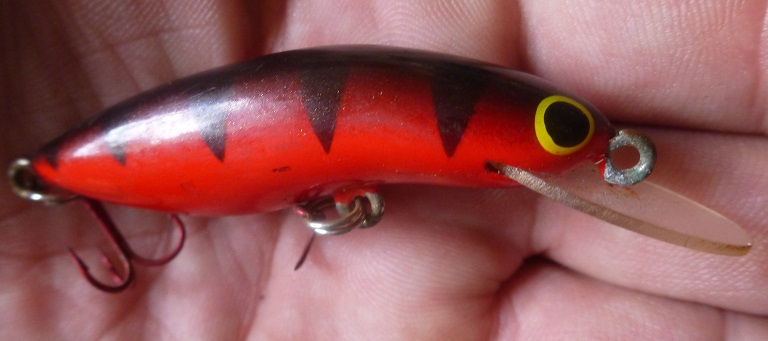
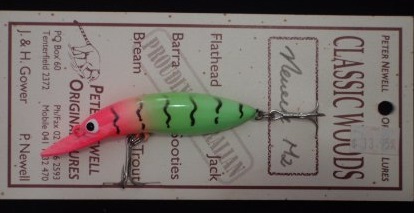
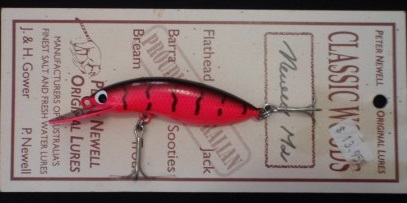
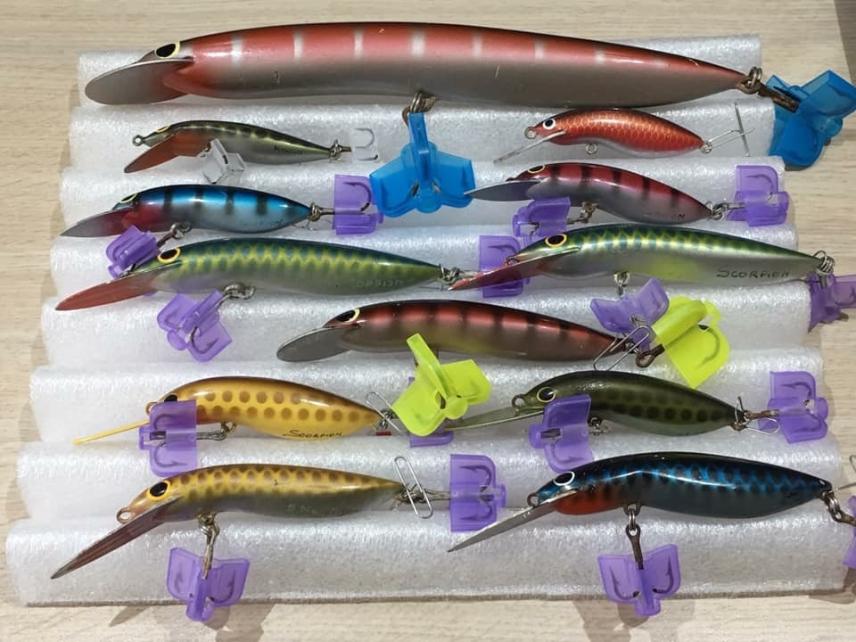
A fine collection of Peter Newell Scorpions showing a range of models from different eras
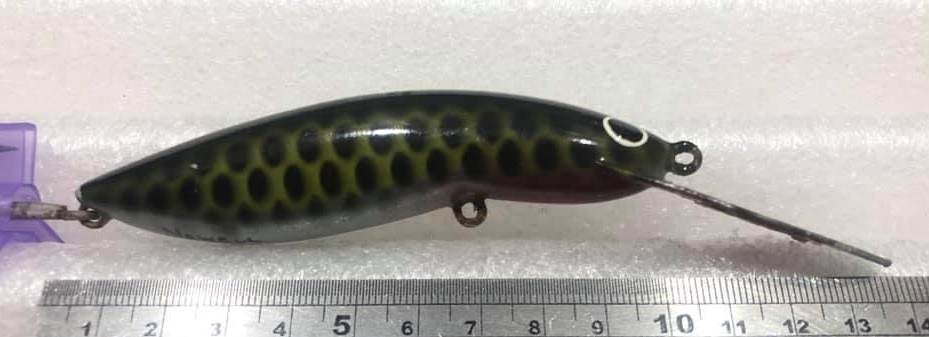
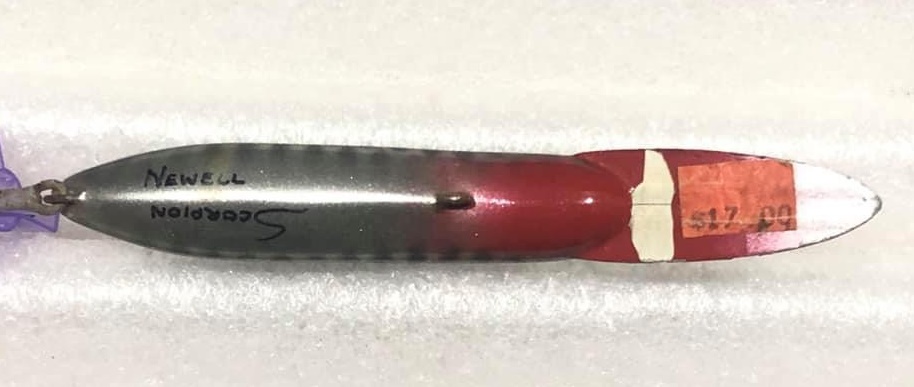
Peter Newell Scorpions continue to fetch high prices from collectors and lures in unused and mint condition have realised prices from $100 - 450 especially if still on original card. Sales on Ebay over the last 5 years have seen the Scorpion designs and various prototypes and uncatalogued colours consistently fetch prices over $100 per lure.
The scorpion design is possibly one of the most copied designs in Australian lure history with many lure makers influenced by the scorpion style lure and Rob Gaden making the scorpions and eventually selling the rights of manufacture of the scorpion to Halco. The story behind the transfer of the scorpion design and rights to make the design which was transferred from Peter Newell to Rob Gaden and then on to Halco will not be explored here in detail.
See more information in full page history in Rob Gaden - RMG Lures and Halco Lures
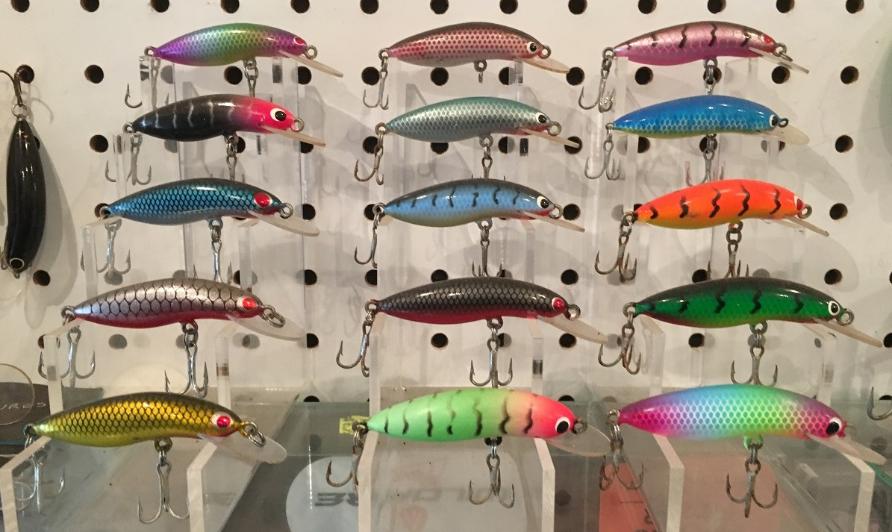
The Newell 'Kadaicha/Kadaitcha':
The 'Kadaitcha' is a sacred word from indigenous Australians that refers to the old legends of the Kadaitcha Man. Each tribe has only one Kadaitcha Man and he is the spiritual leader and part of the oral tradition of Indigenous legends and folklore.
The Newell 'Kadaitcha' has perhaps become one of the most in demand lures for Peter Newell collectors - there are a number of sizes and variations - as with many of Peter's lures the earliest (1983) will have the metal bibs that were cut from the kick plate of screen doors and will have the line down the centre of the bib as shown left in these examples of very early Newell 'Kadaichas' all spelt without the 'T'. Noticeably they all have white/black eye combination which is normally a sign of very early Newells although yellow/black eyes were also used on some of the earlier examples.
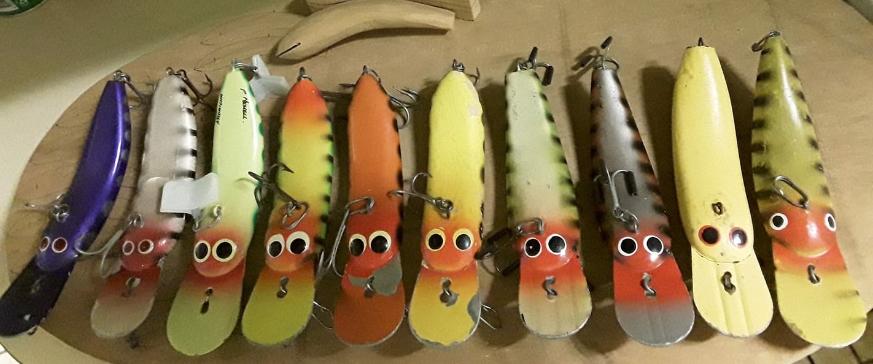
The Newell 'Kadaitcha' evolution of the eyes - oldest from right to left
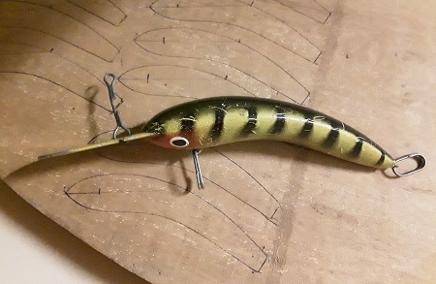
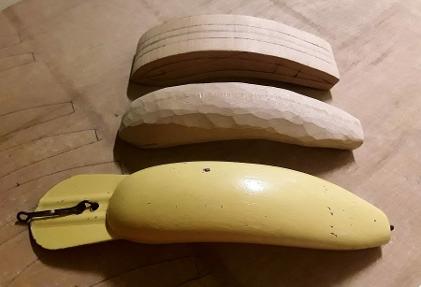
The Newell 'Kadaitcha' history from the Expo display by Mike Gilbert.
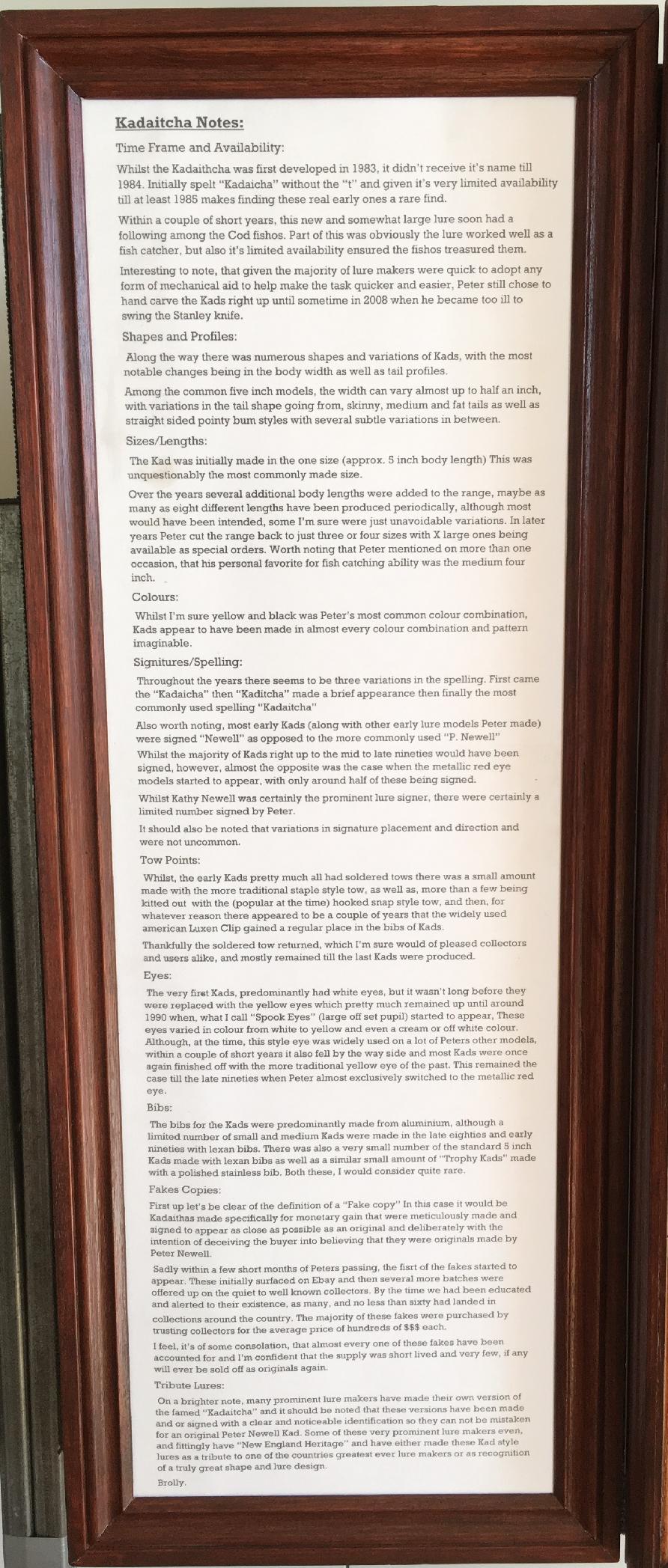
The Newell 'Kadaicha' signature as shown above and close up of the screen door bib 'Kadaicha' with yellow eyes in attractive orange silver stripes. Below shows an early Newell 'Kadaicha' that came onto the market and sold for over $500 in 2014. This is an average price now for these early versions. This one has the smooth bib. The other lures shown sold in the range $550 - 800 mainly due to the near mint condition and with original hooks and split rings.
Original lures with their original trebles and split rings should be as shown with an oval split ring and heavy duty treble hooks plus the customary 'Tenterfield Towpoint', the front towpoint which is a soldered hand made double ring
(Below) The Kadaitcha process from lure blank to finished lure.
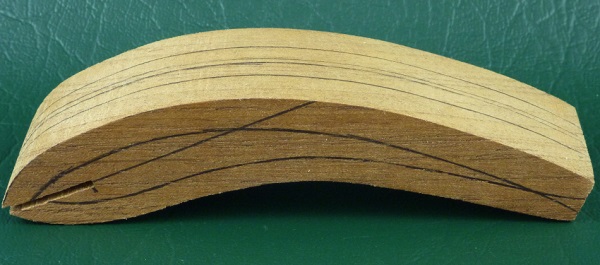

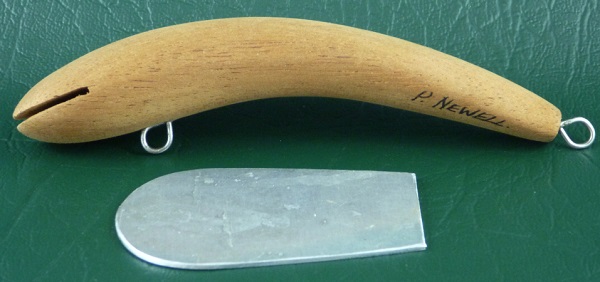
(Below) A photo showing some different Kadaitcha 'Bums' for comparison.

'My understanding having discussed this with Peter is that the original fat bums sometimes laid on their back after being cast. On retrieve they rolled over and dove nicely. This is a pretty exceptional action for a lure but some people were concerned that it took the lure away from the cover at the start of the retieve. The skinny bum Kadaitcha's sit face down.
I believe that Peter made skinny bum lures after that but being the creative bloke that he was he might have still made a few fat bum's for people that liked them or specially requested them. It is one of the problems with creative genius!' Frank Prokop:
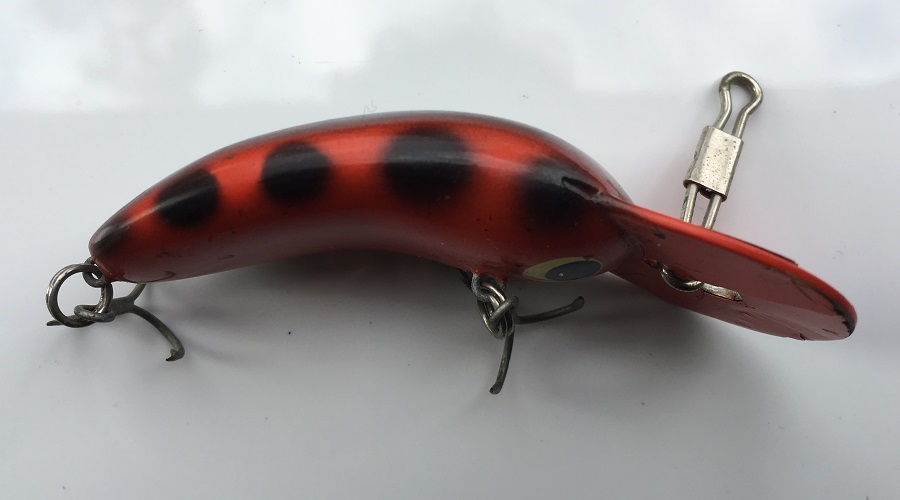
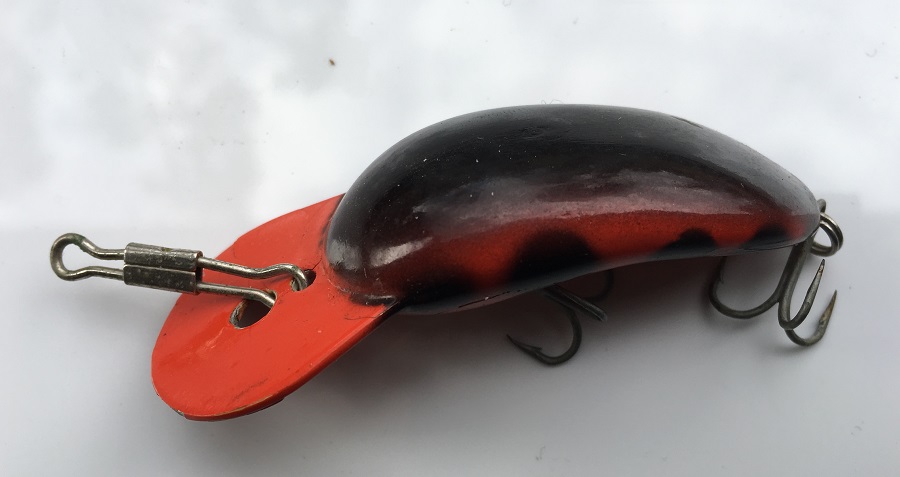
Two videos showing Rod Harrison catching a nice sized Murray Cod on a Newell Kadaitcha.
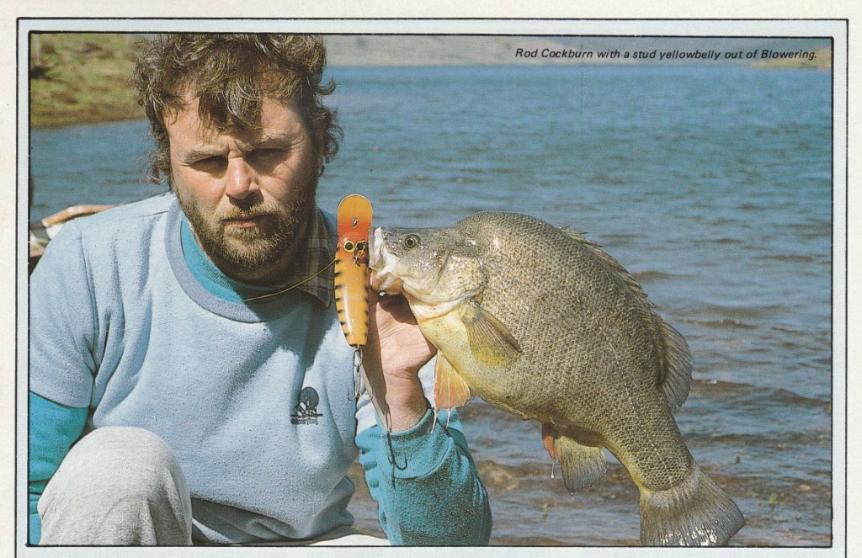
The Newell 'Millenium Kadaitcha':
This was a rare release for the turn of the millennium and 200 individually numbered and signed sets were released in a presentation box complete with thumbprint - rarely does this boxed lure come onto the open market.
The advertisement right appeared in Freshwater Fishing magazine in late 1999 and into early 2000. Unsure exactly how well this lure was subscribed at the time (it seems that there were less than 100 released), however for those who invested the $100 in the year 2000, current value would far exceed the initial outlay cost.
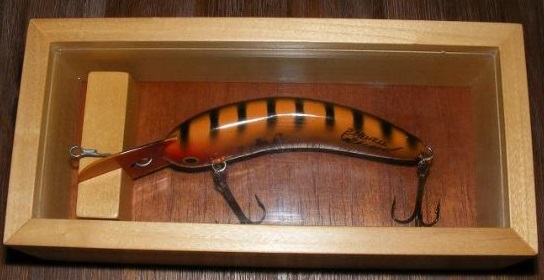
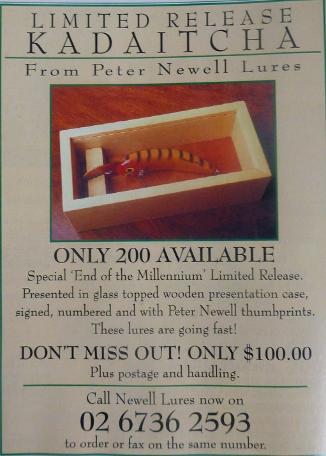
The Newell 'Guppy' and 'Grunts':
The Newell 'Guppy' is an early design of Peter's that dates back to at least the early 1980's and may have originally been called the 'Grunt'. As mentioned earlier there are also a few examples of the 'Guppy' model being signed 'Scorpion Lures'. The photo right as shared by Travers Powell shows the shape of the early model 'Grunt' with the pronounced hump head. Over time it seems the hump was reduced and this model eventually evolved into the 'Guppy' and subsequently into the 'Callop'.
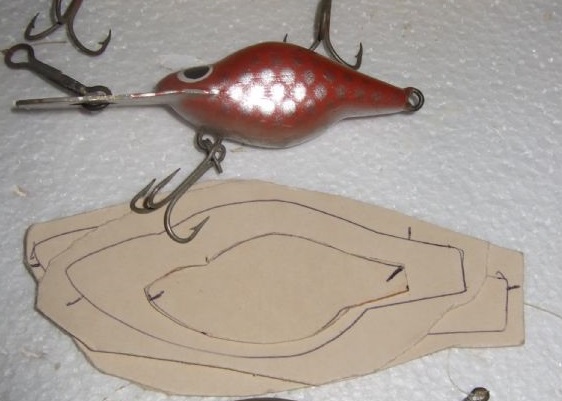
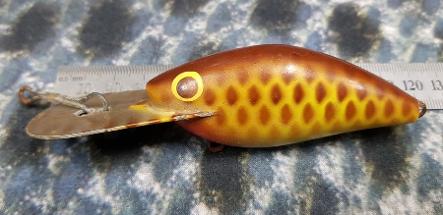
(Above) A larger version
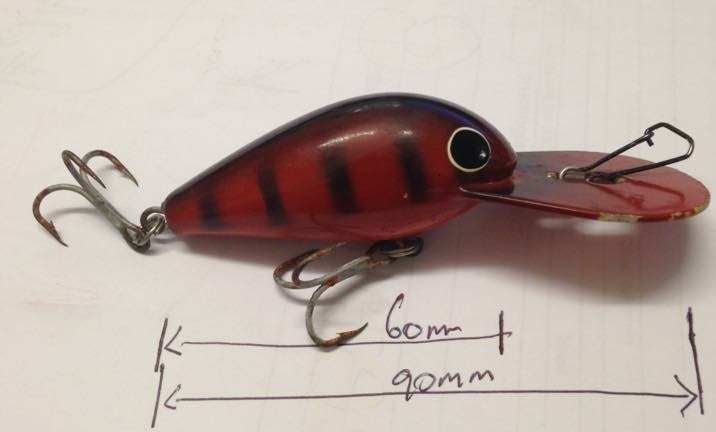
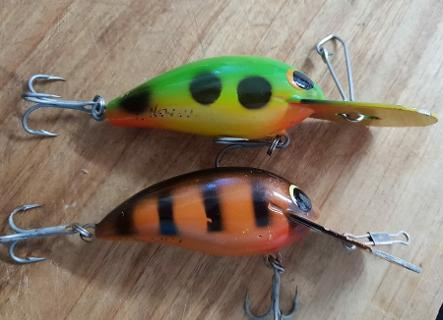
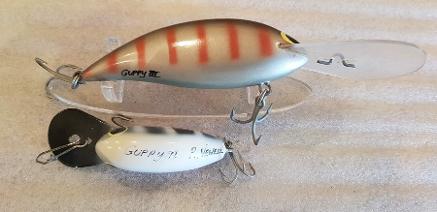
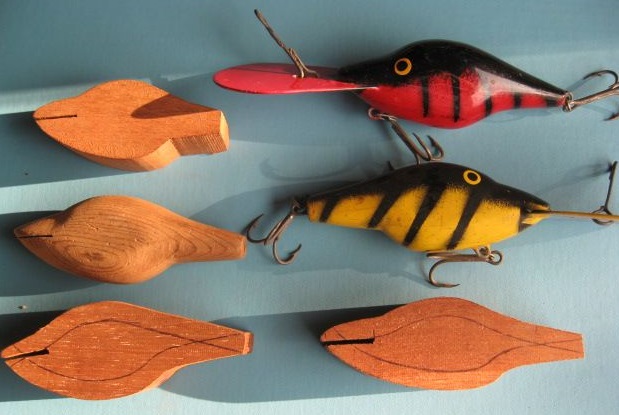
This evolution of the 'Grunt' and 'Guppy' models is illustrated left - some examples of the templates and early model 'Grunt' which has templates for a number of sizes. The lower photos definitively show the evolution of the smoother top and less 'hump'. Again a number of sizes too. One thing noticable is that the bib angle is nearly horizontal (at 180 degrees) from the body and subsequently changed slightly as the 'Guppy' bibs show a slight change in bib angle downward.
(Below) Some early examples of the 'Grunt' and 'Guppy'.
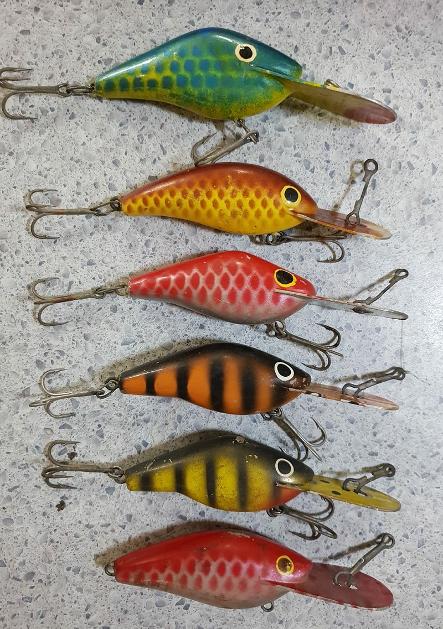
(Below) Grunt/Guppy bib variations
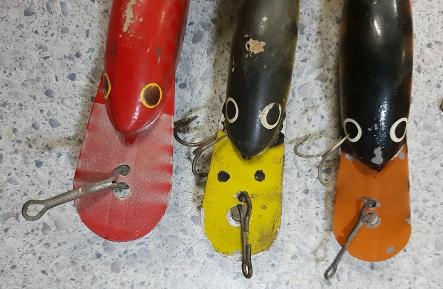
(Below) Some fine examples of the Guppy. You will notice most have the smoother profile and that they were also made with polycarbonate bibs at some later stage.
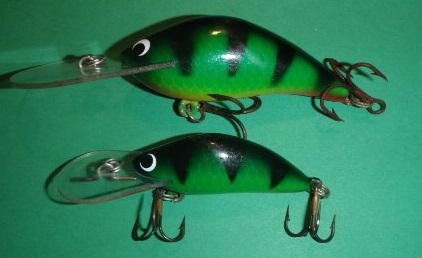
(Left) The Guppy 2 and Guppy 3.
The Newell 'Nulla Nulla':
The story of the Newell 'Nulla Nulla' is a bit obscure - the name is Indigenous and this model is one of the hardest to come across and rarely come onto the market except through collector networks. Opposite shows a rare eraly catalogue featuring 3 sizes of Nulla Nulla
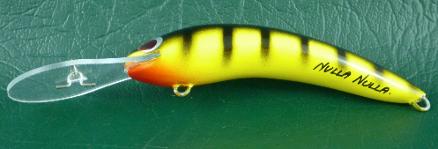
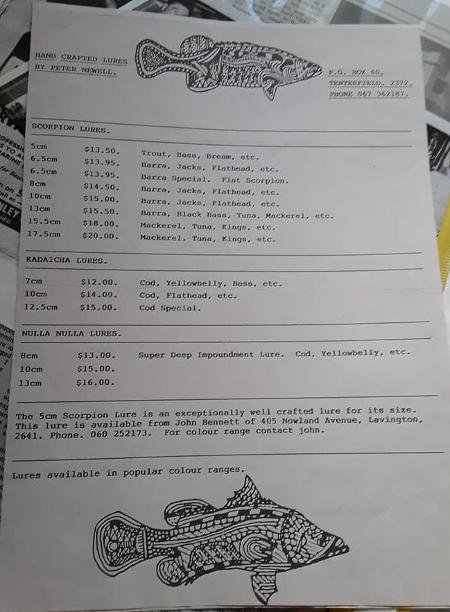
The Newell 'Big O':
The story of a lost lure by Mike 'Brolly' Gilbert
'Now this to me is a real treasured piece of Newell history, not only being based on the early “Big O” shape but also the fact that I have never to this point come across an early Newell “jointed diving” lure before which to me, makes this one quite unique. I was also given a brief bit of history about this particular lure. It was made by Peter Newell in around 1984 for a keen Tenterfield fisho who successfully used it before losing it to a fish or snag. Now the gentlemen I got it from found it in a Tenterfield waterway (the One Mile) in 1985 and let the original owner know at the time they had found it but were happy to keep it. Now some twenty eight years (2013) later these two gentlemen were kind enough to jointly offer it for sale to me to add to my collection. The lure has an overall length in excess of 200mm and as you can see from the pic with how it dwarfs the early and one would think quite rare shallow bibbed Guppy.'
The Newell 'Bumble Bee':
A rare Newell lure is this large Jitterbug style lure surface walker made for Murray Cod fishing. They were not made in large numbers although there are a few out there. Metal bib plate is hand beaten with ring.
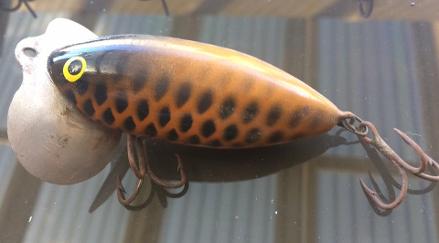
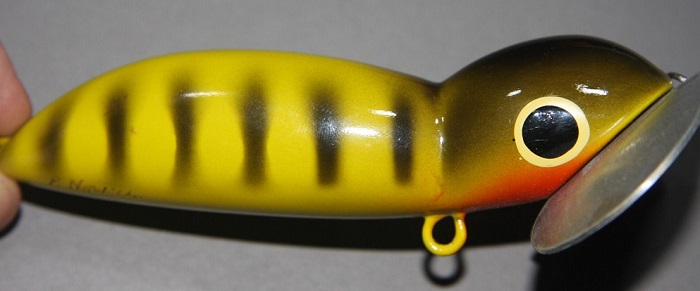
This lure is uncommon and in high demand by Newell collectors and sold for $799 in May 2014 on Ebay. The lure shown below left is a similar Newell model but smaller in size.
The Newell 'Minnow':
A reflection by Travers Powell;
The Newell Minnow: There was one lure that had me scratching my head for a while - it's a
minnow shaped lure with Peter's name on it. I can't remember Peter
making a minnow lure in his range of lures, but there may be some avid
collectors of his lures who may know if this lure is a one-off. My
theory on the lure goes something like this. I used to buy a lot of
George Dempster minnows, when I first went to Tenterfield (1989) -
unfortunately, quite a few of the lures just didn't work, no matter how
much tweeking and bending we tried - so I decided to make my own
minnows (the Macleay Minnow). I have a feeling that during the
development of my minnow shape, Peter knocked up this little number
(with ring-pull bib!) - it would have been about 18-19 years ago. Powelly 2009
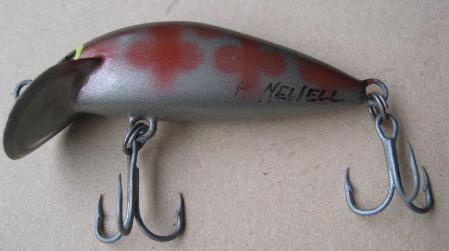
The Newell 'Cray':
In Tenterfield there seems to have been a specific cray shape that developed from the ideas of Peter Newell. It is a classic shape that was made in small numbers and was released with oval split rings as shown in photos .
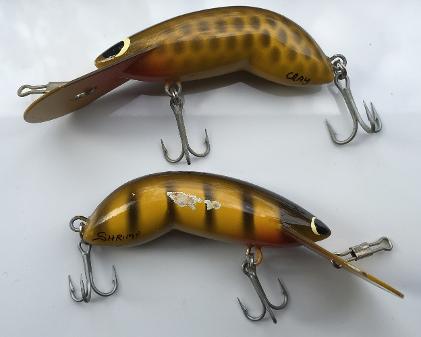
This model is a very original shape and resembles a 'Scorpion' body that is tapered downward towards the tail. A Newell 'Cray' will be marked 'Cray' and due to the rarity are in high demand by Newell collectors. The Newell 'Shrimp' will also be found occassionally and this design was given to Trevor Mc Feeters and hence the Tenterfield 'Shrimp' evolved. Remember Peter and Trevor were good friends and worked together for years and this would have been a verbal agreement between Peter and Trevor.
The Newell 'Jew':
The Newell 'Jew' was only ever made in small numbers and is another of the rare lures made by Peter that is in high demand and hard to put a value on as this model rarely reaches the market.
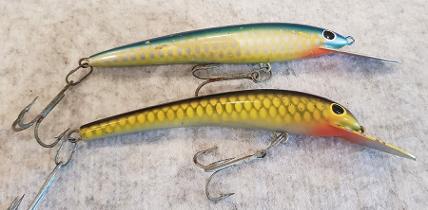
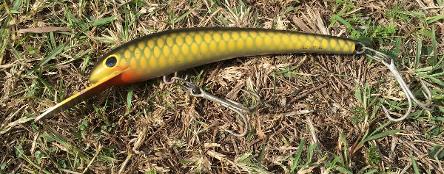
Both lures shown opposite are marked 'Newell Jew' although they have different body shapes.
The Newell 'Special':
The Newell 'Special' is added here as it is similar shape to the 'Jew' model but bigger at 270mm. The lure showcased here is the only one ever sighted and it is unknown if there are any other examples of this model out there. It is a spectacular lure and illustrates that Peter Newell would and could make a lure for any application and the colour combination would definitely attract large fish including the mulloway (jewfish) - it would be interesting to know for what purpose and target the lure was originally made.
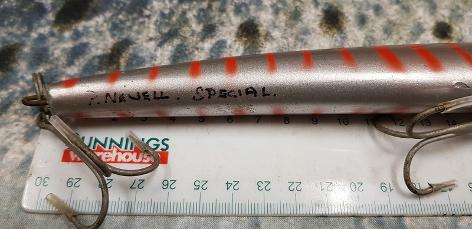
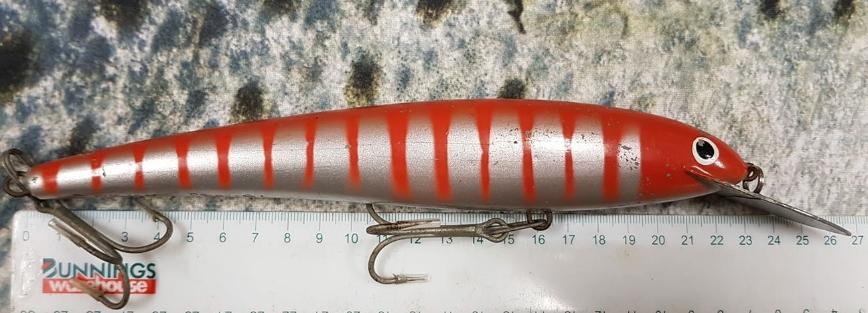
The Newell 'Merlin':
The Peter Newell 'Merlin' is known to have been made as early as 1987 in plastic but this model predates this and was reputedly named by Kathy Newell. During the early 1990's, both Peter Newell and John Bennett were making the 'Merlin' range and the following documents some of the history. The original shape is like a 'squashed' Scorpion
'Back in the early '90's, when the partnership started, John sent a lot of prototypes, turned from different timbers, to Peter for analysis. Peter gave me a few of these.' Travers Powell.
At the time Peter Newell worked with John on the 'Baby Merlin' it was first called a 'Baby Scorpion' and later changed to 'Baby Merlin'. This information was published in Freshwater Fishing Issue 16, p58 in the Gear review section. Its obvious from looking at the 'Merlin' design that it reflects a Newell influence and the 'Merlin' design was used by John Bennett evolving into his range of lures. The lure right is a timber lure from this age that sold at auction for $564 in May 2014.
The Newell 'Myrddid':
During the late 1980's and early 1990's, John Bennett started making the 'Merlin' and there was some collaboration between Peter Newell and John Bennett although they did not work together for long.
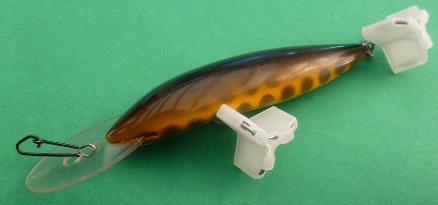
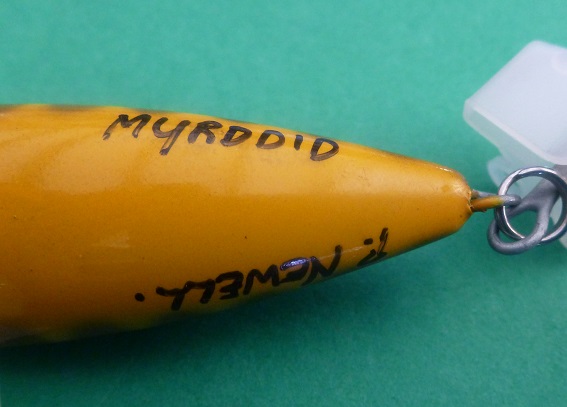
The story behind the above lure is that Myrddid is another mythical wizard from the English and Welsh legends that is reported to be more powerful than Merlin - hence the name.
The Newell 'Beluga':
Another of the older models was the 'Beluga' which is far less common than many of the other Newell models. Shown below is a number of sizes - top three are older and have the eyes on the bottom of the lure.
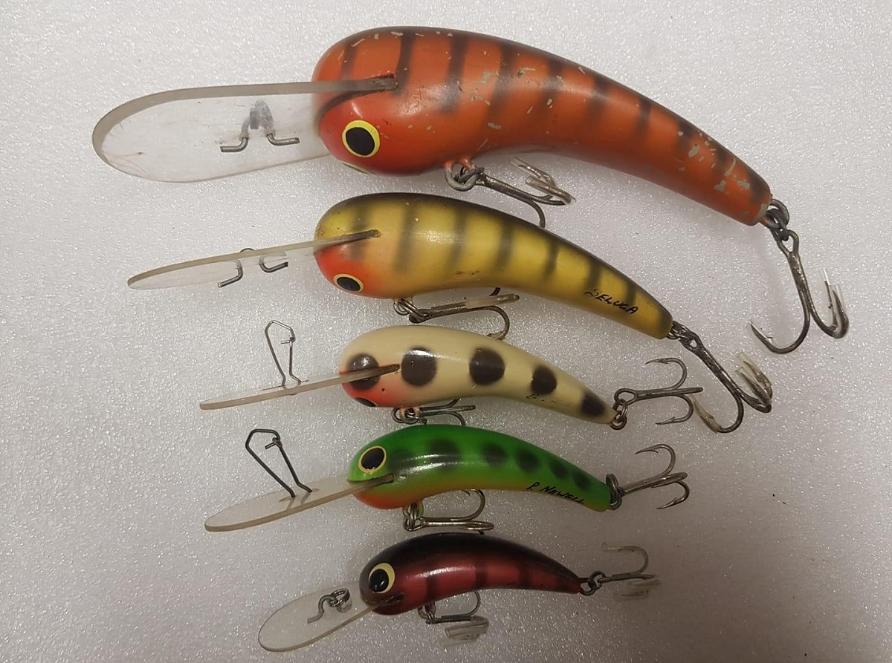
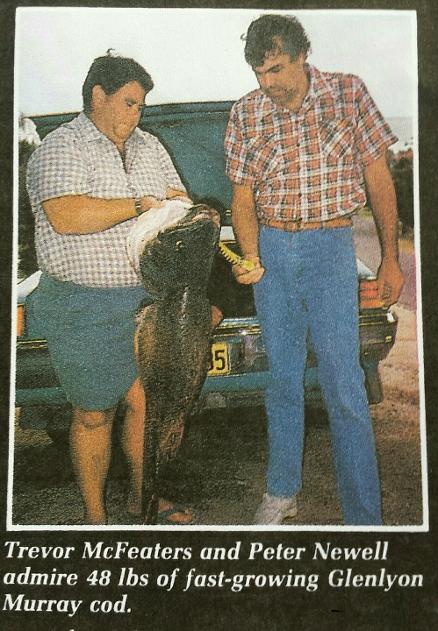
The photo below was taken at Glen Lyon Dam Tourist Park and shows Peter proudly displaying a 40lb Murray Cod which was kept for the table due to its fine eating qualities. This photo would date to approximately 1990 and the fish would most probably have been caught on a 'Kadaitcha' lure.
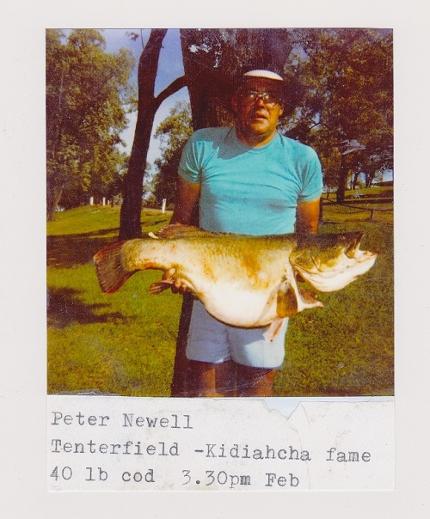
The Newell 'Boney':
The 'Boney' was a staple in the Newell/Gower partnership although it was developed by Peter before the business partnership. It is one of the less common models especially a 'Boney' with a metal bib as shown lower left in photo below.
(Right) 'Boney' on card from the Newell/Gower partnership.
(Below) Earlier version on card.
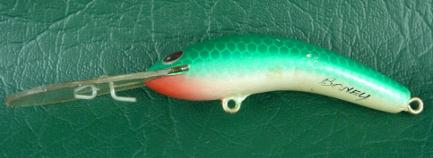
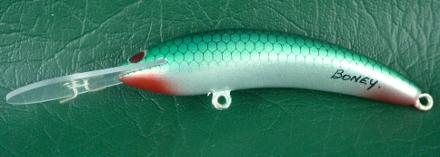

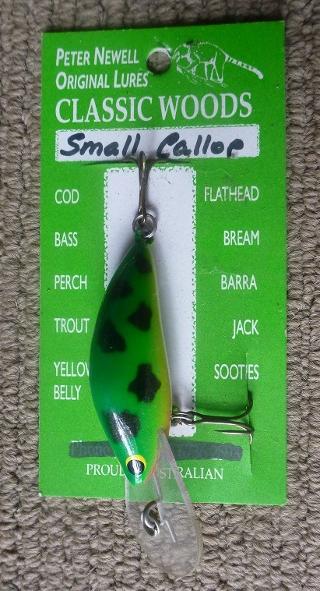
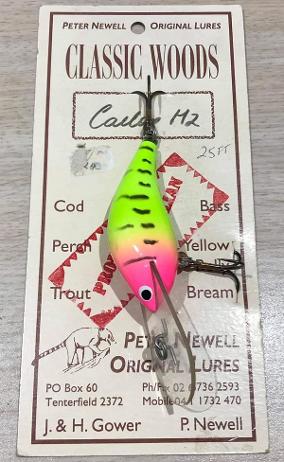
The Newell 'Callop':
The 'Callop' as mentioned earlier probably evolved from the earlier 'Grunt/Guppy' pattern and was a popular model made in two sizes and known as the M1 (50mm) and M2 (70mm). Photo below shows earlier Callop model on green card - labelled small Callop as opposed to M1.
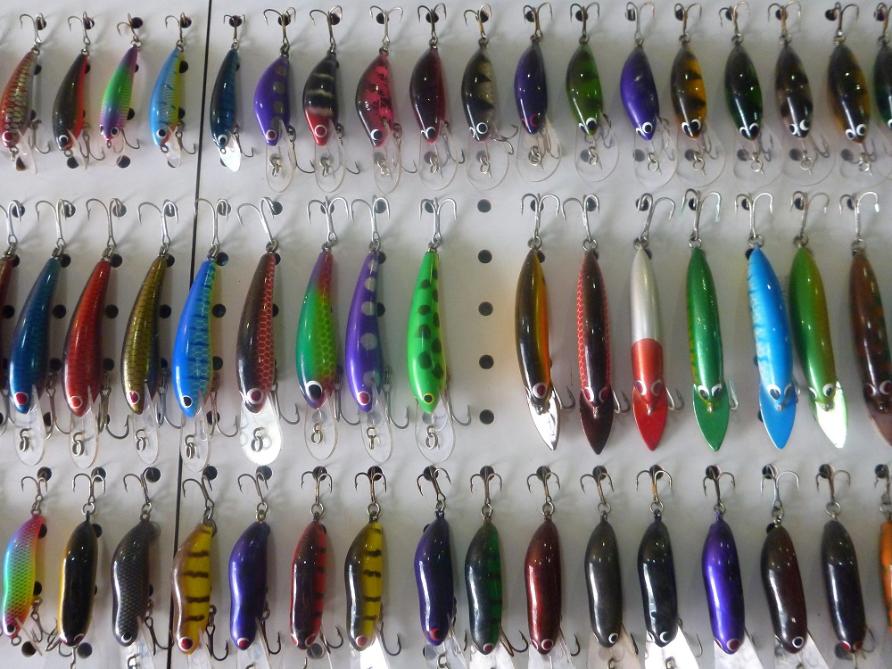
The photo above illustrates a few variations to discuss when identifying original Peter Newell lures marketed before the Gower partnership. Newell collector Michael Gilbert explains;
'I have no Newell lures or history of Newell lures that would suggest the red and silver eyes were used before 1998 (mid Gower era). All original Gower/Newell catalogues, first printed mid to late 1996 feature black on white eyes.Official Gower Era was only approx five years 1996 to 2001.'
Furthermore in reference to Kadaitcha bib towpoints;
'a lot of the Kads he made in the 2000's had soldered tow.The luxon clip and the hooked snap which were both used at times on Kads (and other models) were relatively short lived.'
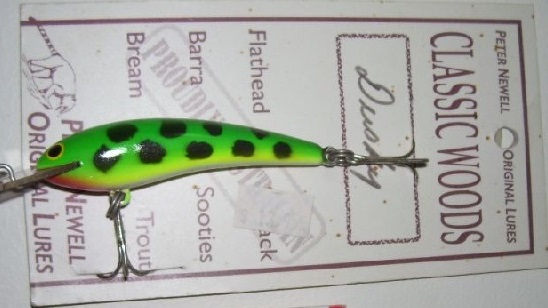
The Newell 'Dusky':
This model was another that was released by Peter before the Gower partnership as shown on the card below.
The Newell 'Bass Rat' and 'Trout Rat':
These models were a later release . ..
The Newell 'Ploppy': The plastic revolution
The 'Ploppy' was Peter Newell's foray into the world of plastics technology.
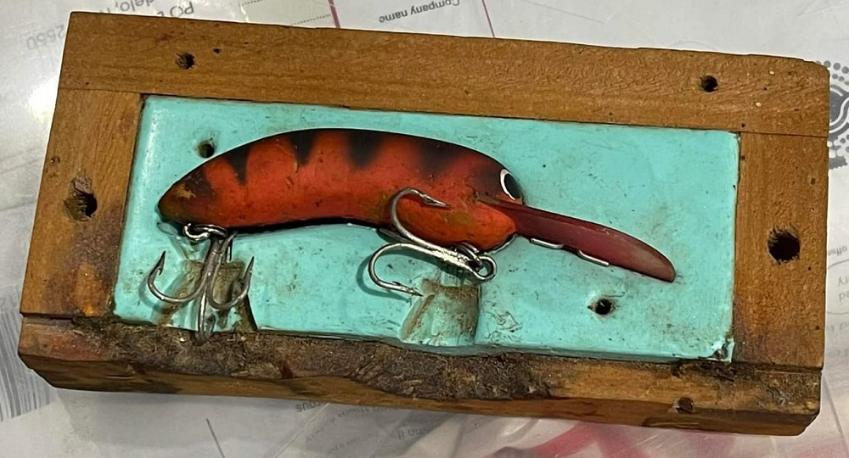
The Newell 'The Coati or Coatimundi':
Classic later model that came closely after the Ploppy - Peter was unhappy that he could not use the Scorpion name so came up with 'The Coati' - Coati is short for coatimundi the animal pictured on his Classic woods cards and catalogue. The name was given to the lures after the Scorpion shape was sold off as 'Coatimundi's eat Scorpions'.
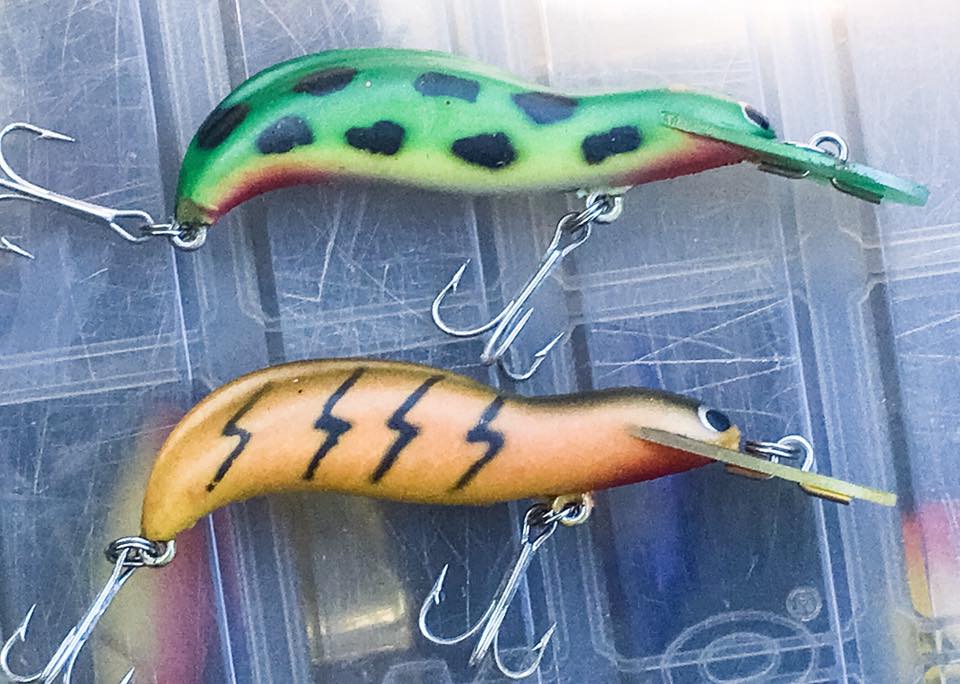
The Newell 'Water Dragon':
Another uncommon model. Not sure of timeline. More info soon .
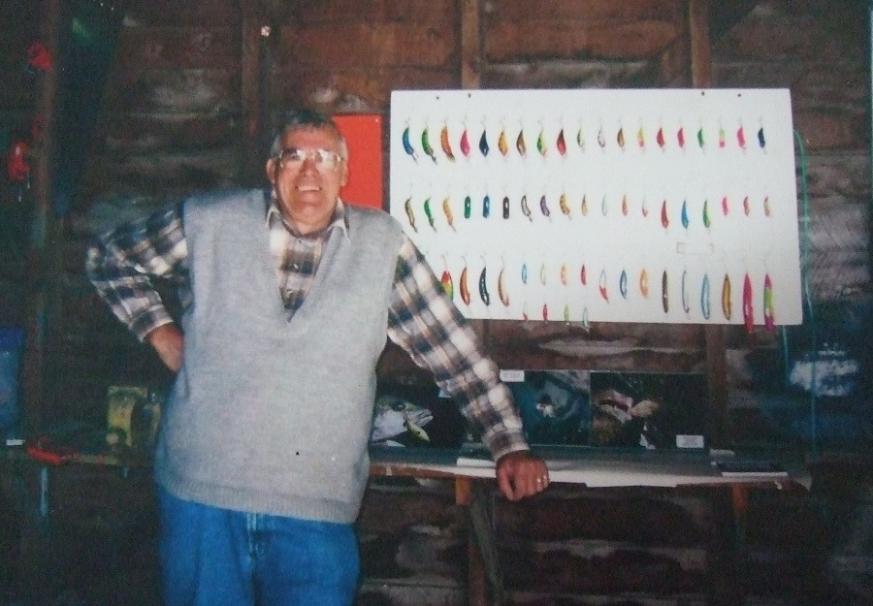
Peter Newell Card History
Peter Newell Original Lures Blue Cards;
The Peter Newell Original Lures blue cards are shown below for the 'Coati'.
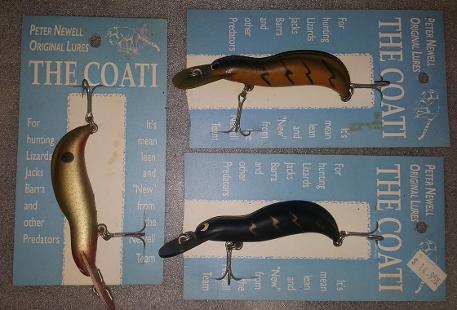
The three above have faded a little but the lure below shows the sky blue colouration of the original cards. Above are earlier cards without the later addition of 'Trade Enquiries' with phone number and promotion for the 'Ploppy'.
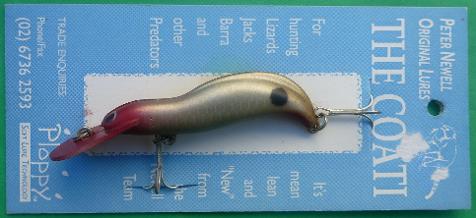
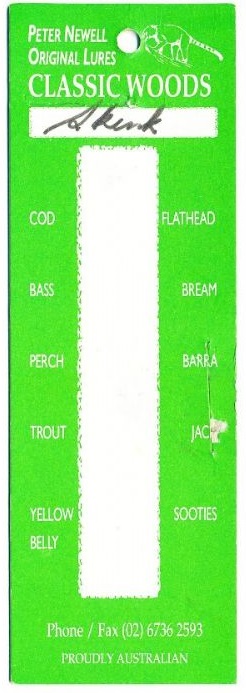
The green cards will contain many of the earlier models that Peter made and came in a shorter and longer card. The shorter cards were used for models such as the smaller' Kadaitchas' and 'Callop'. These cards were posted on the Lure Lovers forum in 2014
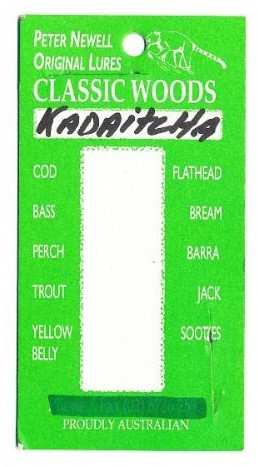
Above shows another variation of the 'Ploppy' Card with Newell/ Gower and early Steinbrook Road address.
Classic Woods Green Card
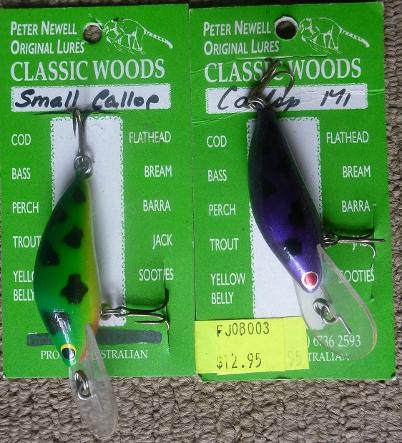
Classic Woods Cream Card - Newell/Gower
The Peter Newell partnership with John and Heather Gower saw a change in packaging and there are some variations once the 'Classic Woods' range was continued. As the cards show right the 'Proudly Australian' stamp can be found in a couple of variations once the J & H Gower names were added to the bottom left of the cards. The first and rarest card is the Classic Woods card for 'Scorpion Lures' - this card was very short lived and was not allowed to be used after Halco secured the rights to maunfacture the 'Scorpion' model from RMG Lures in 1995. These cards were posted on the Lure Lovers forum in 2014.
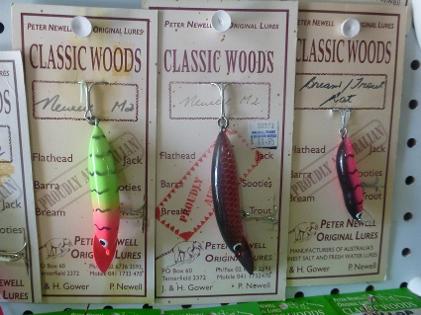
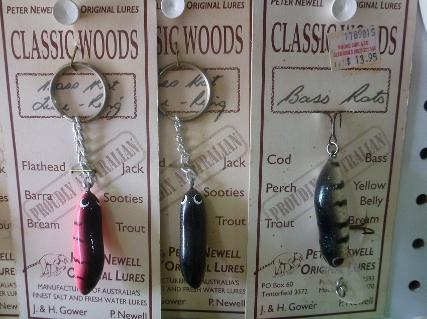
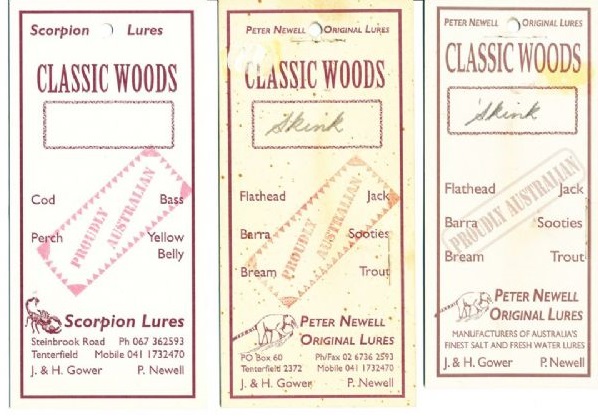
(Left) The furthest card to the right for the 'Bream/Trout Rat' shows the Newell/Gower card when the address and phone details were omitted and replaced with the slogan 'Manufacturers of Australia's finest salt and fresh water lures'. These variations will help in dating any Newells that are found on the original cards. The red 'Proudly Australian' stamp is the earliest which was changed later to the narrower version directly printed to the card.
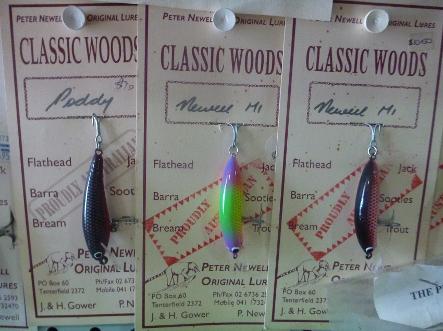
(Left) The 'Bass Rat' were also released as a keyring.
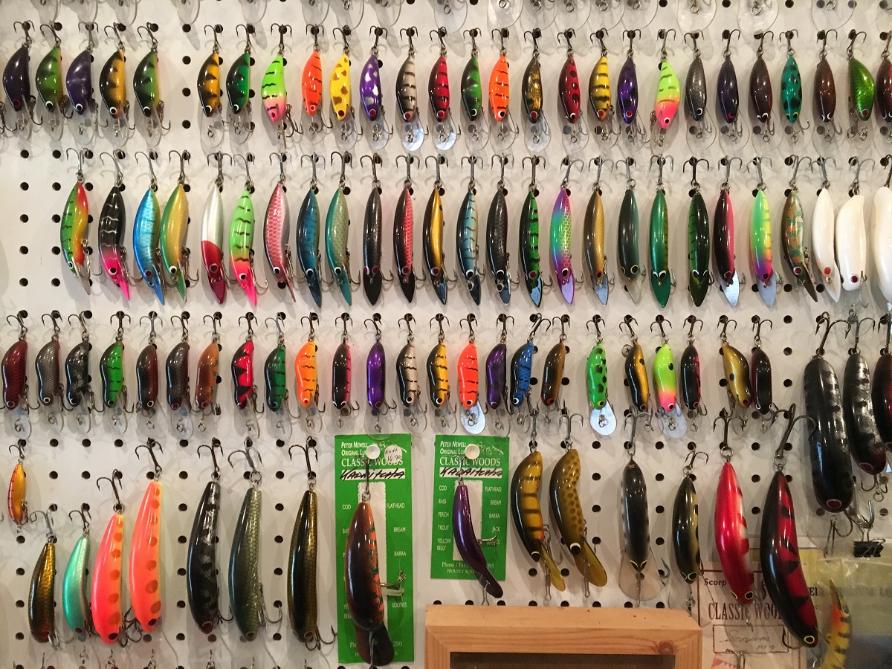
Articles about Peter Newell
Below is the promotional page from Modern Fishing, August, 1983 which advertised the upcoming article called 'How to Roll Your Own' which ran in the September, 1983 Edition. It used this article as a feature and considering the time it was published it seems that Peter was already a much admired and respected lure maker by 1983 with a wide range of patterns firmly established.
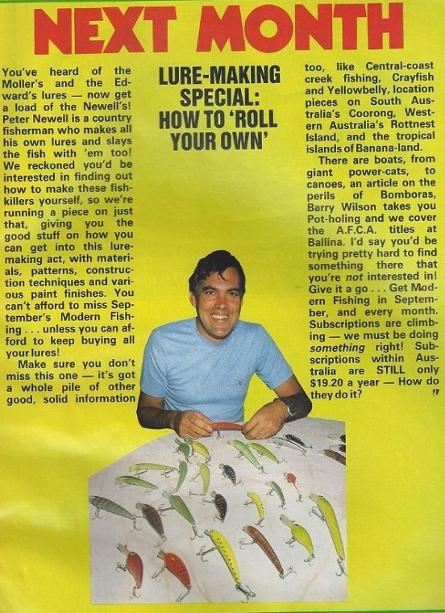
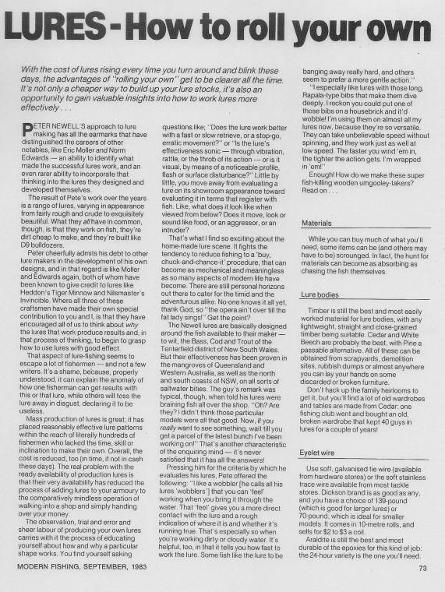
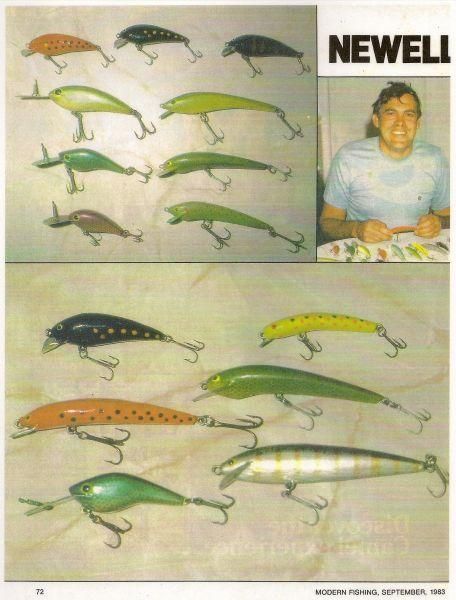
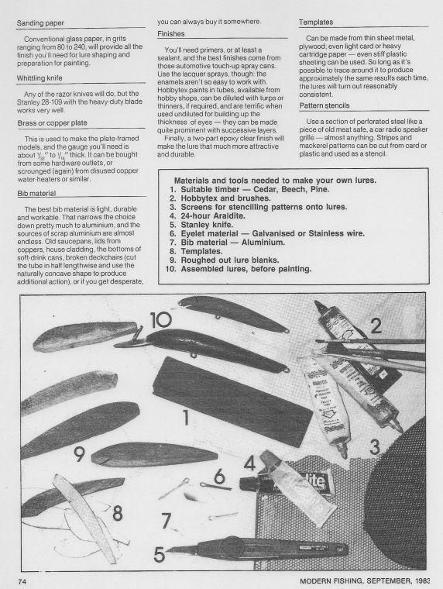
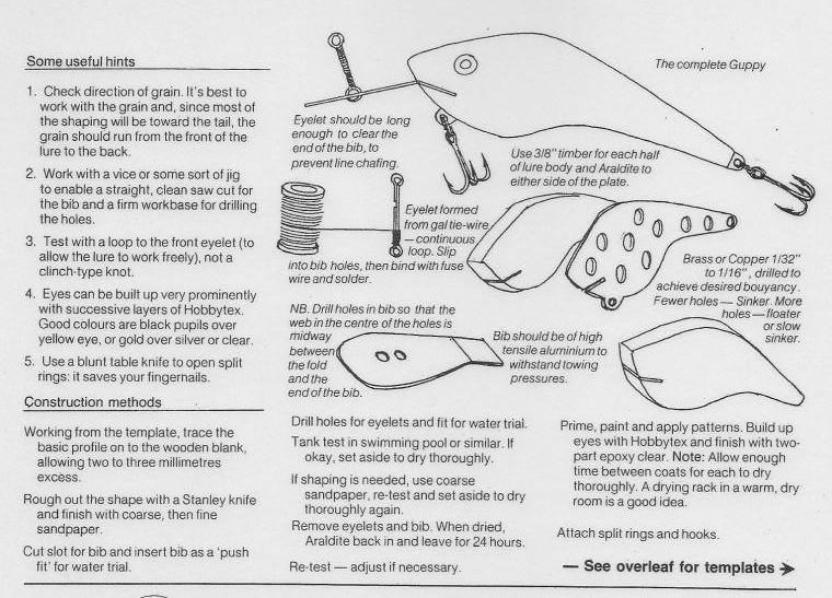
Below is another article, 'Minnows you can Make' that was published in Modern Fishing the following year - July, 1984.
It refers and gives instructions on how to make the 'Chin Minnow'
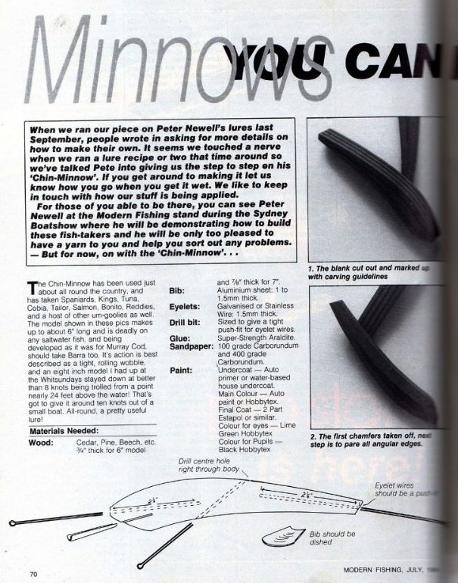
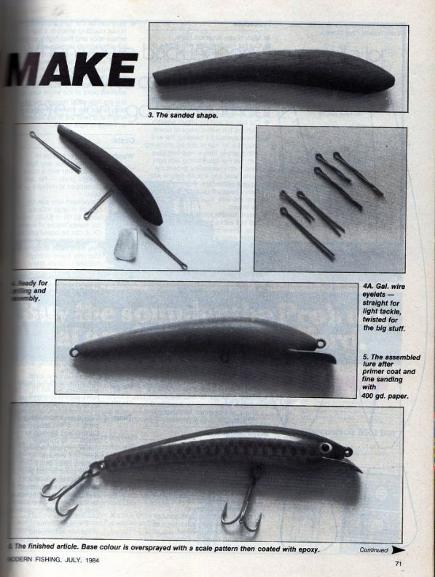
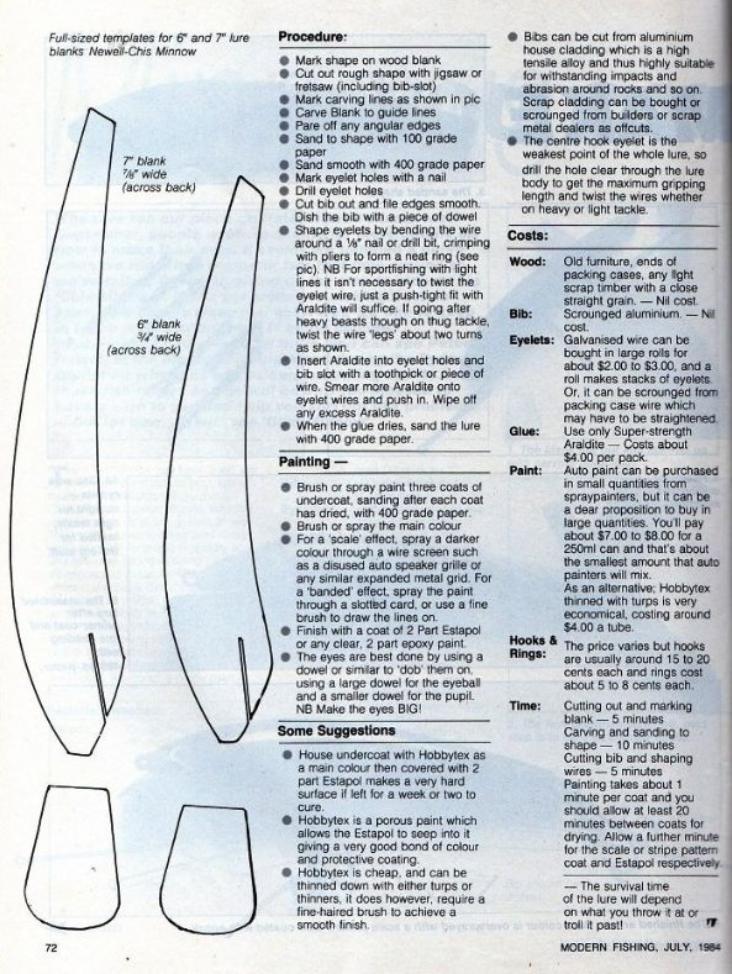
The Newell Lures catalogue showing the lures and colours available during the Newell/Gower partnership.
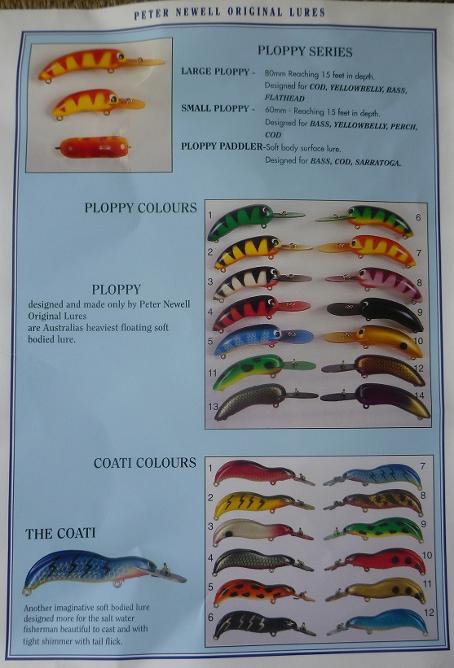
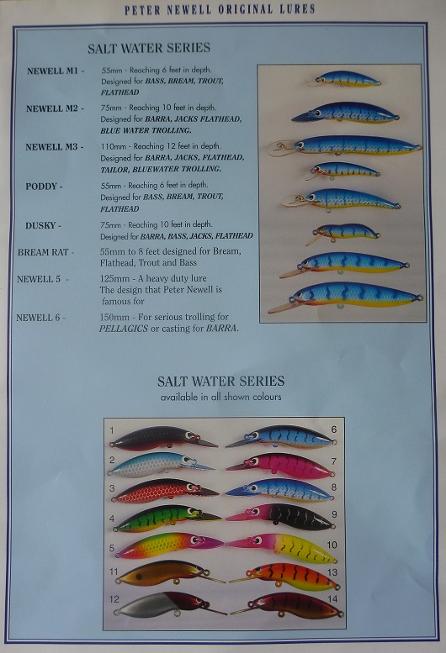
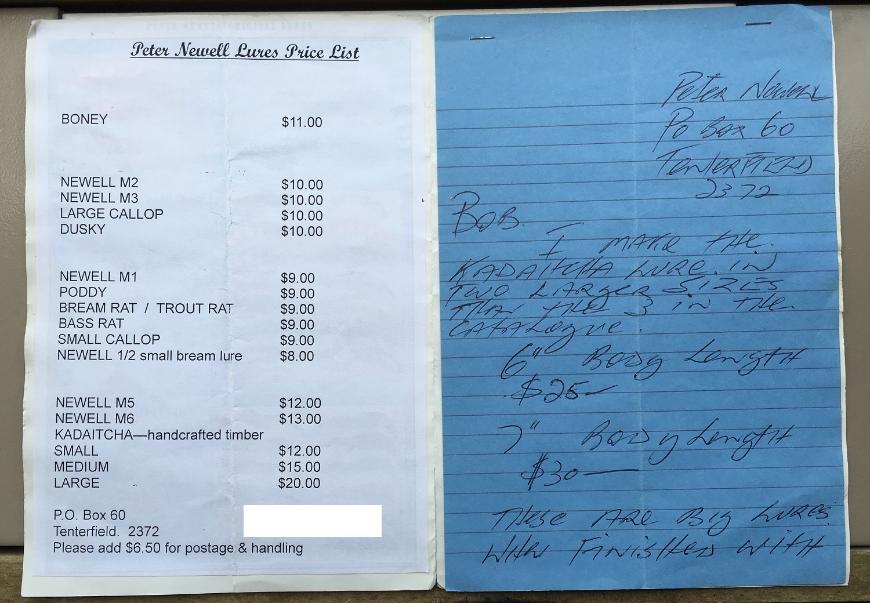
The Bream/Trout Rat was reviewed in Freshwater Fishing, 2000
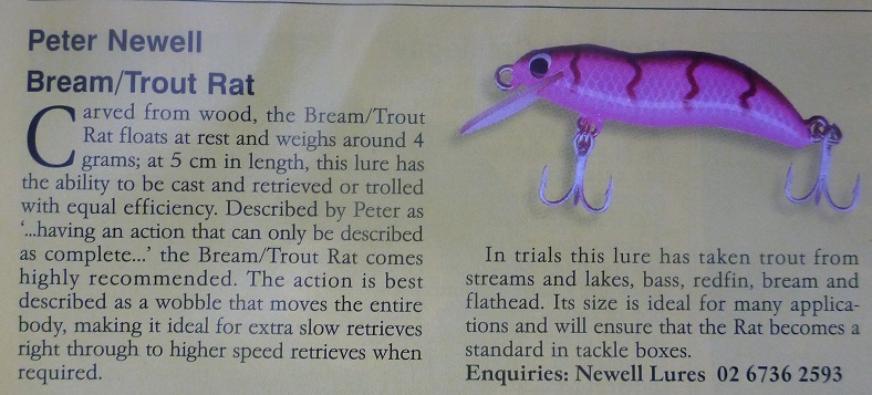
Some Peter Newell Lures advertising c.2000
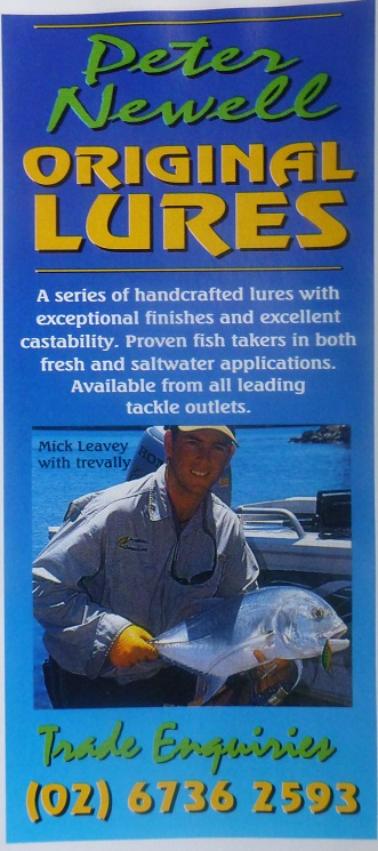
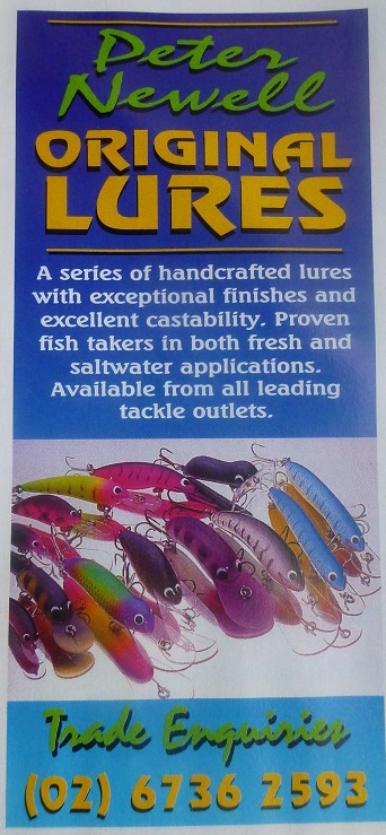
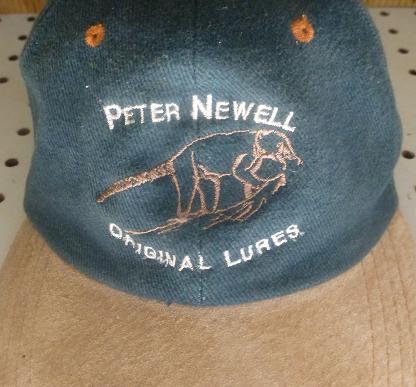
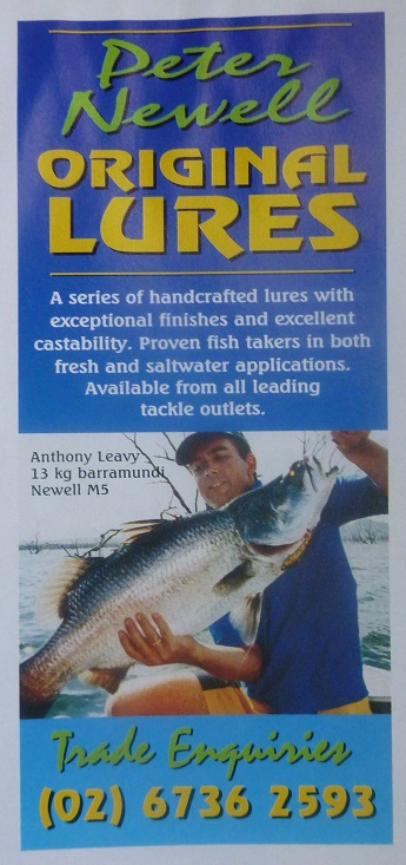
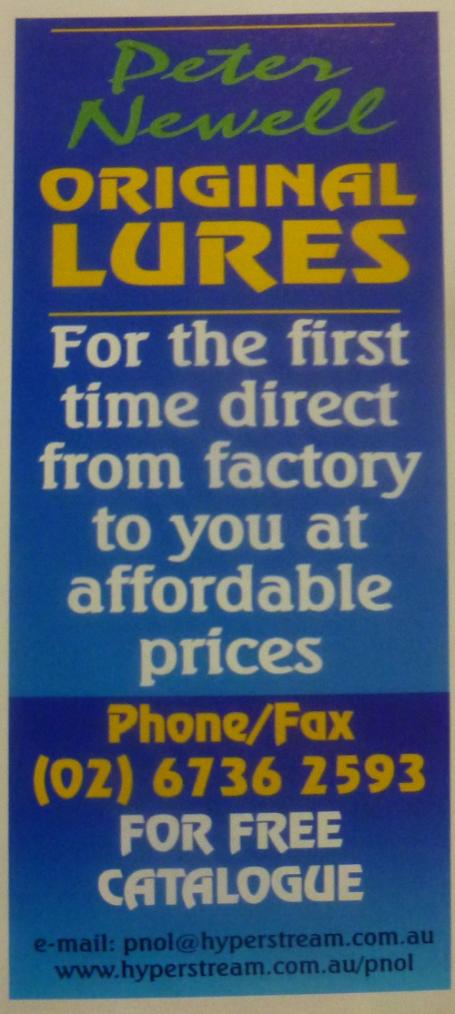
The above Newell advertisement introduced an email address and website link for Newell Lures and a free catalogue. This may have been during the Gower era as production was ramped up after the year 2000.
The hat left shows the 'Coati' logo which would have been made at the same time as the blue carded lures.
Peter Douglas Newell lived a life of creation and his legacy to the Australian lure making fraternity and, anglers in general, is as large as any. Peter recently passed away at home with his family and will be sorely missed. Following are some tributes from those who new and dealt with Peter throughout his wonderful life.
Lure making guru Peter Newell certainly fits the bill of the last two categories and even though he didn’t put his head up too high too often, Peter endured more than his fair share of bad luck. It is a real tragedy that this icon of Australian lure making lost his fight with cancer in early January 2009, passing away peacefully with his beloved wife Kathy and good friend Brett Campbell there to hold his hand.
In my opinion Peter Newell is arguably the greatest lure maker Australia has produced. With Norm Edwards and Eric Moller with barra lures, Peter Newell put Australian native fish lures on the map. Peter was everything you could want in a friend and a pioneer. He was innovative, extremely good with his hands and generous with his time, ideas and lures.
While Peter is responsible for some of the best-known lure designs in Australia, it is for two lures that Peter will go down in history.
The first is perhaps the longest running saga in Australian lure making, the Scorpion. Peter no longer made the Scorpion and many stories abound about this Australian classic, which is now made by Halco in Fremantle. Suffice to say that Peter’s generous nature and willingness to extend a helping hand has not always resulted in the recognition that many felt was due to him.
In spite of numerous setbacks Peter was still an optimist. Only a few days before he passed away, Peter was talking to me about needing only a few days to knock out some lures that we had been talking about for some time. Such was the nature of the man, thinking about others even when extremely ill.
But for me the Kadaitcha lure will always be the first and foremost Australian native fish lure. Inspired by, but greatly modified from the Bagley’s Smoo, the Kadaitcha was named by me as the definitive cod lure in my Lure Encyclopaedia. It earned this honour both for its fish catching ability and the fact that this design alone, in my opinion, inspired so many Australian lure makers to experiment and make the best damn lures in the world.
I first met Peter after following the advice of Rod Harrison to call in and see this really great lure maker in Tenterfield. Rod and Peter were both Coppers back then and (with Vic McCristal, Gordon Winter and Bryan Pratt) were some of the people who recognised that cod and yellowbelly were legitimate sportsfish and great lure takers. Peter gave me a couple of Kadaitchas and directions to a spot where both my dad and wife caught their first ever Murray cod on lures. I lost one of the Kadaitchas on my third cast when I threw the lure over a branch and a 20lb cod took the lure as it hung over the water and broke me off. The lure was that good that it didn’t even have to get wet to get a fish!
Peter went on to become a great innovator and his designs, such as the Skink, Boney, Beluga and Bass Rat in timber and the Ploppy, Coati and Tenterfield Surface Paddler in soft rubber over a wooden core, are very keenly sought by collectors. It is a sad reflection on us all that Peter didn’t get the financial benefits while alive that his talents deserved. A mint Kadaitcha can sell for over $600, yet Peter sold them for $20 and gave young upstarts like me some because he knew that they would be cherished.
Late last year when I knew Peter was becoming more ill, I was looking to start up a lure and tackle-collecting club. I was looking for a name that would be inspirational and there is no better name than the Kadaitcha Club. It honours a man who is sorely missed and in spite of several setbacks, was always a true friend and gentleman.
On behalf of all anglers in Australia, I can only thank Peter for his enormous contribution and express the hope that through the Kadaitcha Club and the hearts and minds of his many friends, and other lure makers that he inspired, that the legacy of this quiet achiever will last at least as long as his lures.
More info on the Kadaitcha Club can be found at www.lureandmore.com. – Frank Prokop
We’re deeply saddened to report the passing of Peter Newell. Peter carved out a reputation as Australia’s pre-eminent lure designer/manufacturer, but more importantly as a wonderful family man to his wife Kathy and his two daughters, Angela and Roselee.
Over the past few weeks we have had many heartfelt conversations with various people from the fishing tackle community expressing their sadness on hearing of Peter’s passing, I have been touched to hear of the great stories and the fantastic legacy that Peter Newell has left behind in people’s hearts.
Over the past 18 months I have had the great opportunity to get to know Peter, working with him on a new lure range. I will endeavour with determination to build Peter’s dreams of turning his babies (his lures) into a worldwide legacy of the man, but that is for another day, today we pay our deepest respects to a wonderful human being.
I will finish with a quote from world renown lure expert and historian Frank Prokop: “Peter Newell must always be remembered as one of, if not, the most innovative lure designers of his time”
Vale Peter Newell. – Trent Glover
The most remarkable thing about Peter was that he was the most innovative lure maker of my generation. Peter invented what we call the Scorpion shape – a minnow with a keel on the bottom and a sharp edge along each side on the back. These days you’ll see innumerable lures following that design.
Pete had an amazing sensitivity to what would make a piece of wood or metal wobble in a particular way. He could make everything from a slow side-to-side for cod or a tight wiggle for barra. He had a real handle on what makes a lure do what.
He was happy to share his knowledge and skill, mentoring many lure makers in this country, including some of the big names around the game. When any young person approached him with an interest in making lures, Peter would do anything he possibly could to help them.
He was a terrific bloke, generous to a fault. – Warren Steptoe